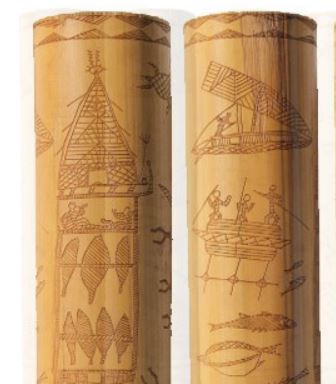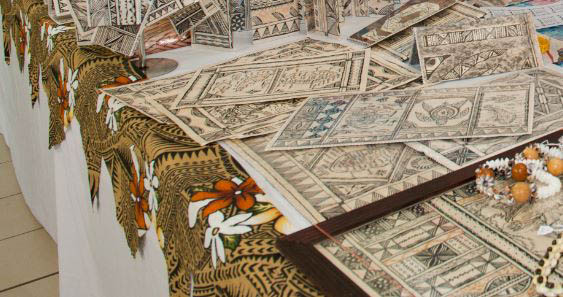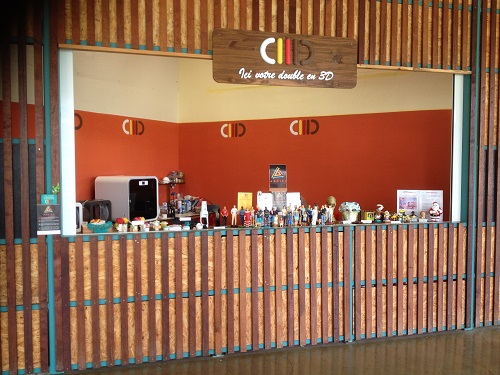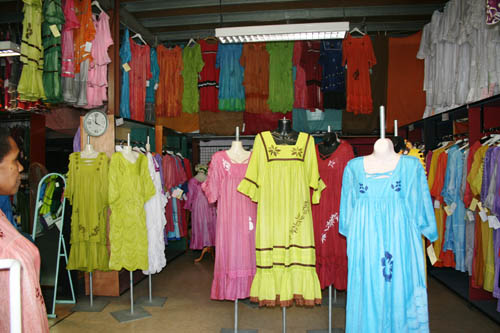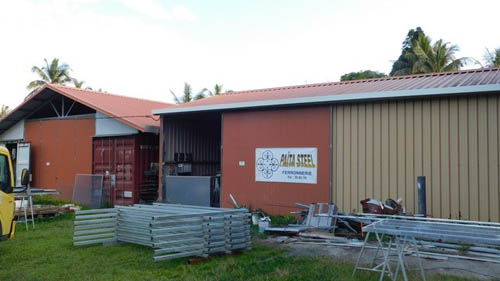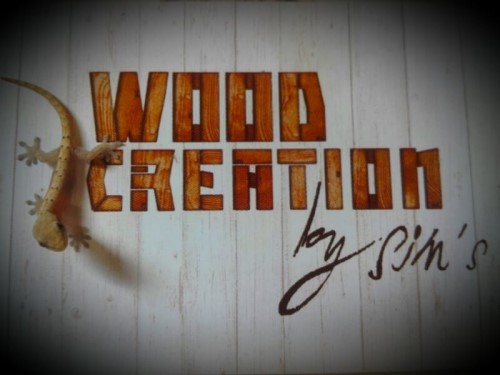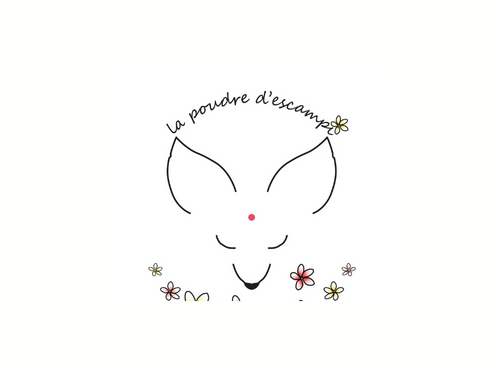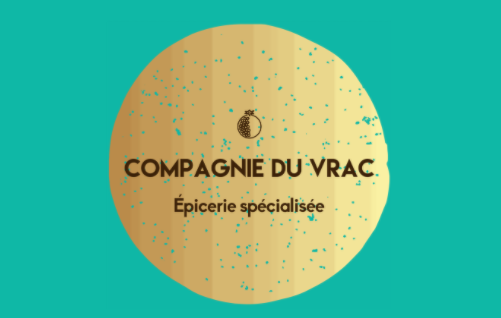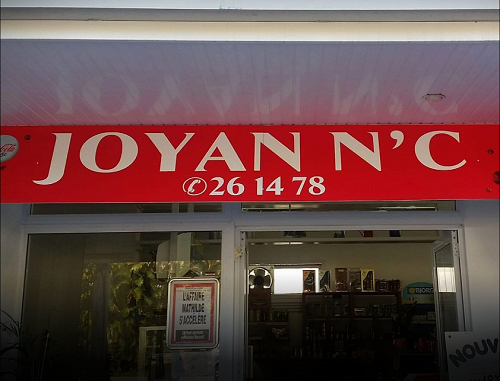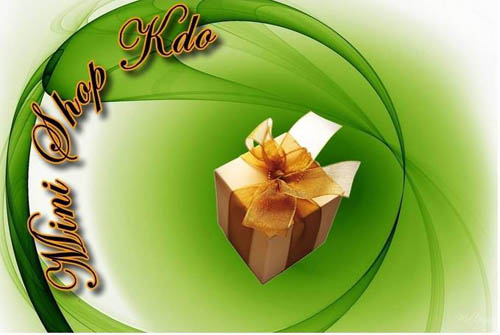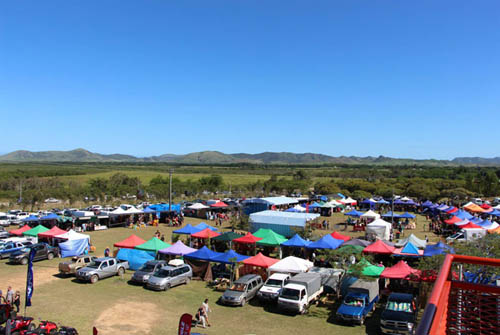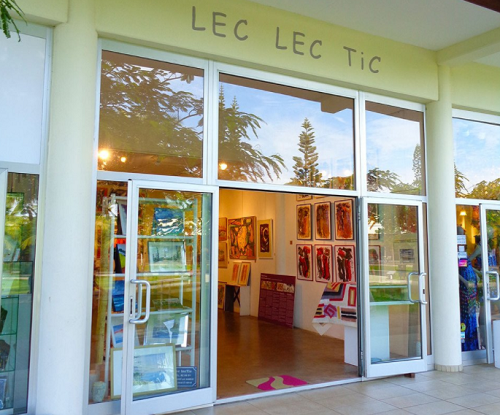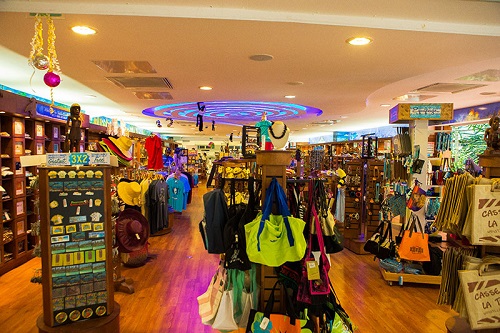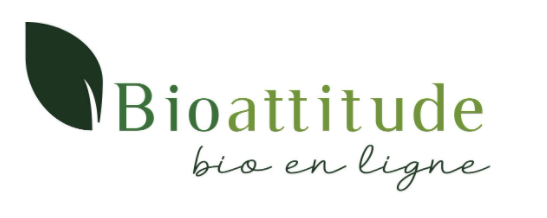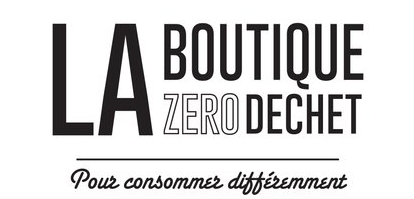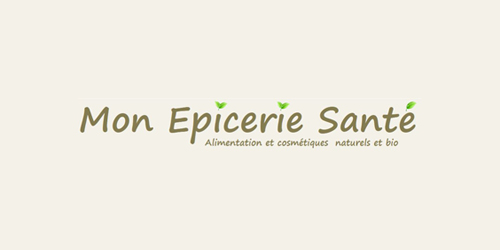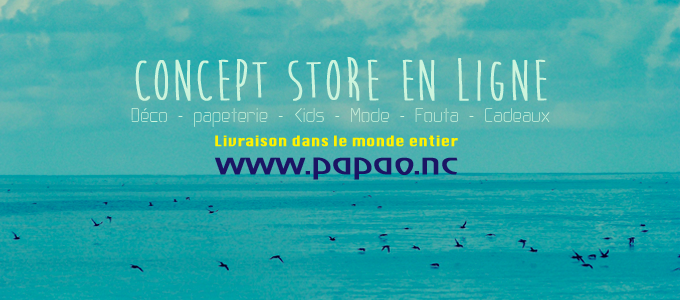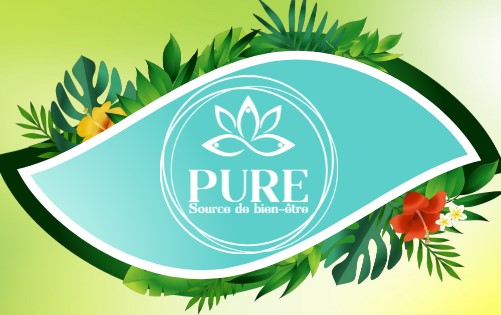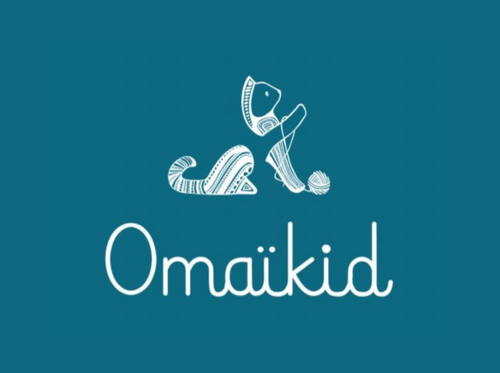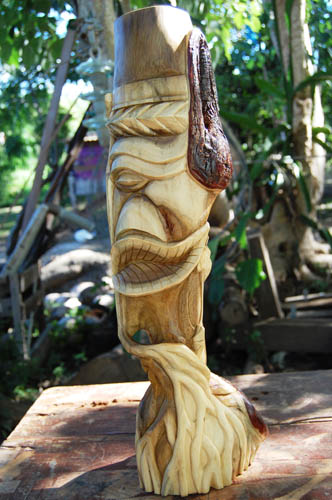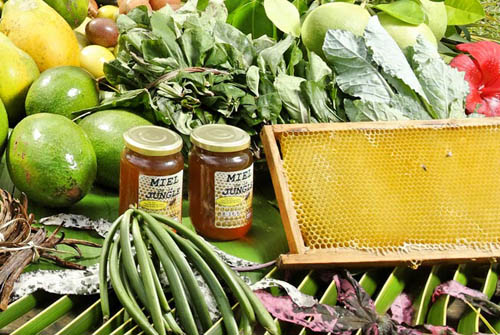Key point: product origin
Some products on sale in downtown Nouméa stores and souvenir shops may look like authentic New Caledonian products but they are imports and not genuine at all.
So take care in checking where your souvenir gifts come from !
ARDICI logo-stamped items are limited series, made-to-order or one-off pieces crafted by local professionals and offer you the following guarantees :
- Products made to the highest traditions of New Caledonian craftsmanship, requiring technical skill and expertise
- Products made, modelled and finished in New Caledonia
- Businesses recognised and approved by the New Caledonia Chamber of Trades and Crafts
- Designers and craftspeople who draw their inspiration from the beauties and resources of our island country
- Products rooted in and sourced from New Caledonia’s local economy through direct distribution channels.
Wooden craft from New-Caledonia
Travelers going back to Australia are able to bring wood items from New-Caledonia as personal consignments without an import permit or phytosanitary certificate if wooden crafts and packaging are free of biosecurity risk material such as mentioned in the document below.
For further information consult the Australian web site here.
Download the certificate
Check out our iconic products
Here is a non-exhaustive list of New Caledonian handcrafted products ideal as gifts for friends or family or as a treat for yourself.

Sculptures & carvings
The rooftop totems which adorn the apex of traditional huts reflect the great significance of woodcarving in Kanak culture: an ancestral tradition, a symbol of clan identity and a tribute to the ancients. A sculptor in wood must master many skills: choosing the perfect type of local wood, shaping the design, preparing the base, sanding, applying finishes and polishing the completed artwork. The two species of wood most commonly used by woodcarvers in New Caledonia are gaïac and rosewood. Sandalwood, in the Loyalty Islands, and houp are used more rarely.
Articles in local wood
Kohu, kauri, houp, gaïac, column pine... New Caledonia boasts an abundance of local wood species. The crafting of wood reveals the secrets hidden within the precious raw material, and artisans give full rein to their creativity with through their woodturning skills, creating furniture and decorative items, traditional or innovative sculptures, picture frames or musical instruments.
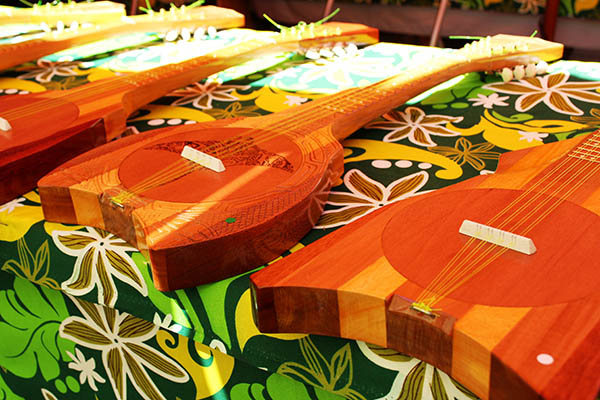
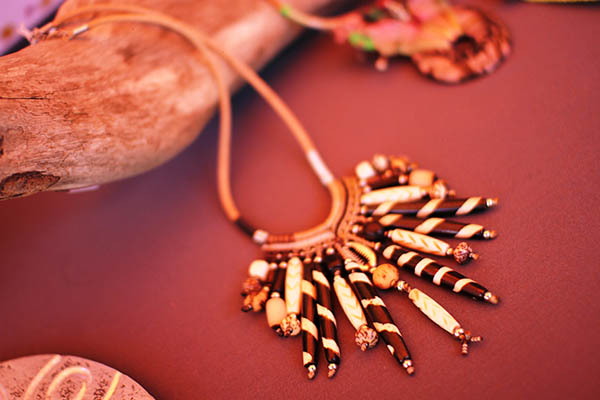
Jewelry made from seeds, shells, local stones or precious metals
Slate pencil urchins, local seeds, seashells, feathers... a host of natural materials which become charming pieces of jewellery in the hands of skilled artisans. You will easily find nature-inspired jewellery like this in New Caledonia’s local markets, to take home as delightful souvenirs of your stay. New Caledonia is blessed with a lavish profusion of natural stones, embellished by artisan gemcutters who create unique pendants and necklaces from Bourail bluestone, mauve marble from Koumac and jade from the Blue River.
Woven artworks
Pandanus and coconut palm leaves, rushes and a variety of plants can be woven to create practical or decorative articles: bags, cases or sheaths, hats, fans, hanging mobiles, paniers, baskets... Traditional weaving skills are passed down by women from one generation to the next. Woven pandanus mats are used in customary ceremonies, with the woven strands symbolising the bonds woven between people. You will find mats in various sizes, each designed for a specific occasion.
Please note: Due to Australian and New Zealand plant health regulations, you won’t be able to take woven articles back home to either country.
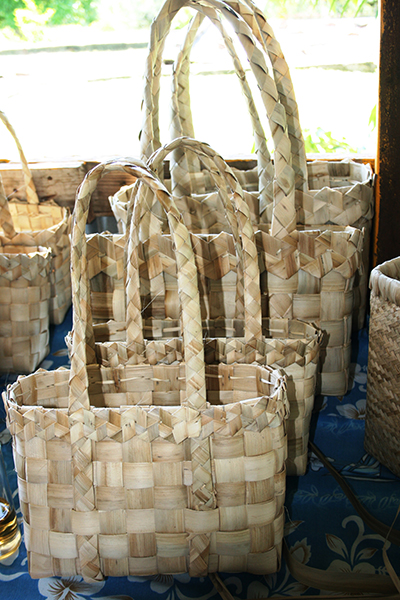
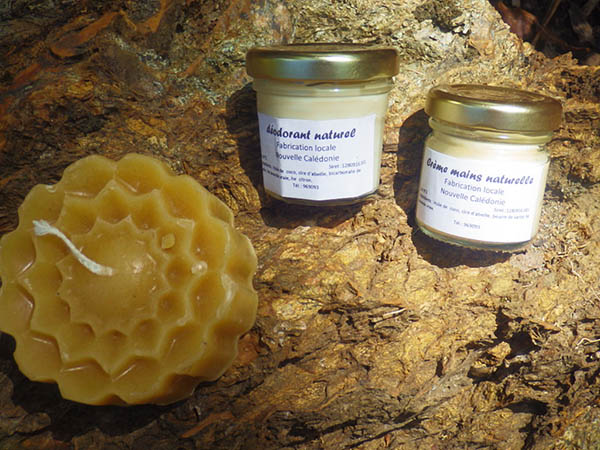
Beauty care products made from New Caledonia’s natural resources
Creams, perfumes, deodorants, soaps... A range of beauty care products are created and prepared by local artisans committed to environmentally friendly, sustainable skin care and beauty. Their watchword: natural compositions containing ingredients sourced from New Caledonia's forests, beaches and gardens: niaouli, tamanu, gaïac, sandalwood, aloe, frangipani and tiaré blossoms, sand... and also coffee, vanilla, coconut, and even propolis and beeswax from local hives.
Essential oils
Tamanu, candlenut, sandalwood and niaouli, icon of the New Caledonian outback and traditionally prized by Kanak communities for its healing and disinfectant properties... Our island country is blessed with a wealth of species possessing precious virtues. Nowadays, the leaves are distilled to extract essential oils to soothe and heal, beautify our skin and enhance our wellbeing.
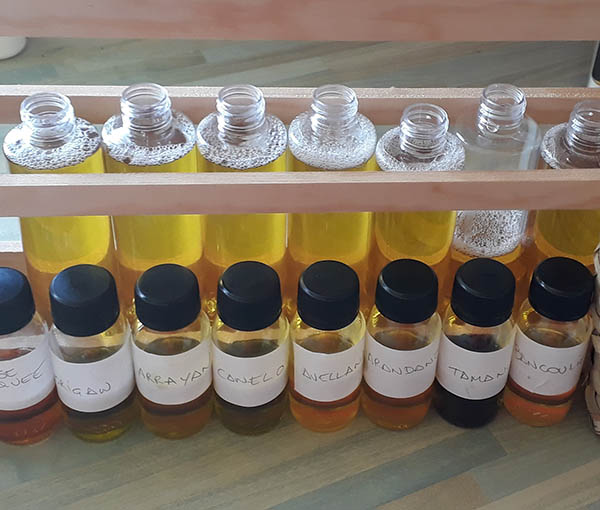
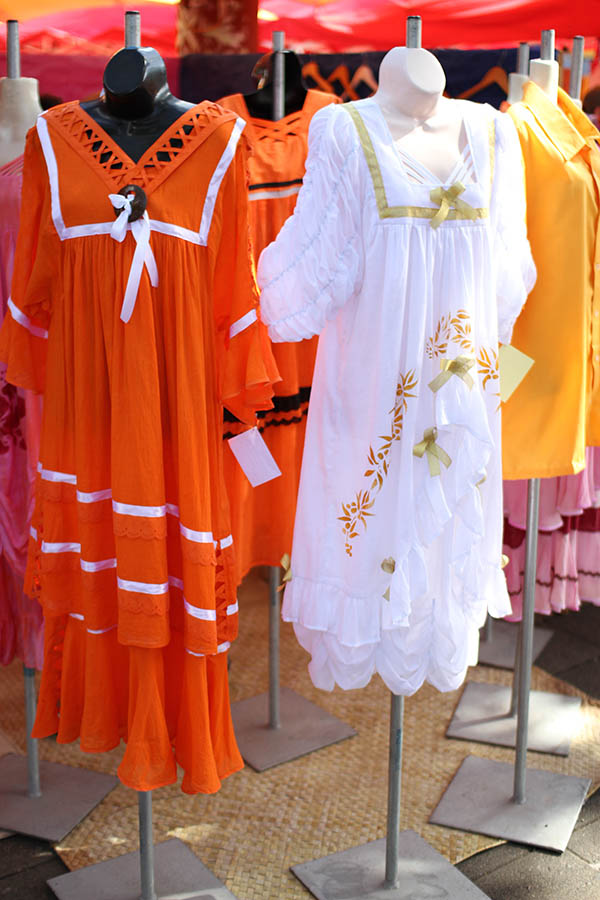
Mother Hubbard dresses
Mother Hubbard dresses are long and loose; they have modest round necks and are usually brightly coloured. They were introduced by 19th Christian missionaries who judged female native garb to be unseemly. Today, Mother Hubbard dresses are worn proudly as a symbol of Melanesian femininity. Originally, only Kanak women wore the garment, but other women followed suit and the basic design has grown more innovative. The same applies to Tahitian dresses, which are now seen as an emblem of traditional craft skills and Oceanian creativity.
Hand-painted “manous” and sarongs
A “manou” is far more than a piece of brightly coloured cloth, it plays a central role in Kanak customary ritual. Accompanied by tobacco and a small amount of money, a manou is given as a customary gift. In some customary areas, it has been replaced by a woven pandanus mat. This “customary gesture”, which precedes any spoken exchange, is a mark of consideration and respect between host and guest. It is an ancient customary ritual reflecting Melanesian cultural tradition. Today, manous have also taken on a new life as attractive sarongs hand-dyed or decorated with painted designs by local artisans. They make delightful souvenirs!
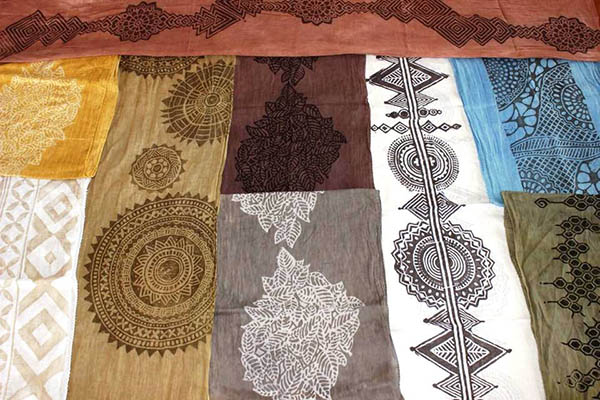
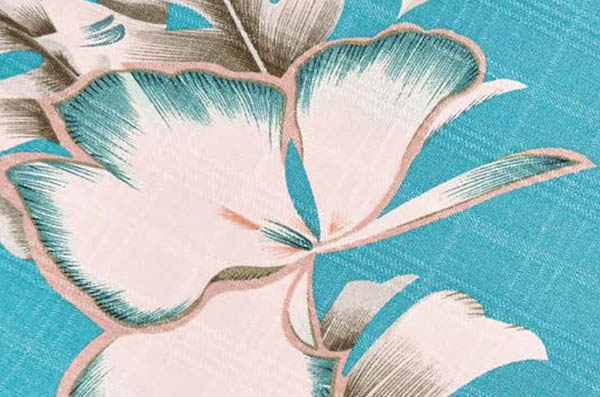
Fabric fashions and accessories
Local designers create and make - from start to finish - apparel and accessories for adults and kids, blending on-trend style with Oceanian tradition and a hint of French elegance. They use materials inspired by New Caledonia's natural beauties: fabrics are hand-dyed using craft methods and adorned with beads, shells and lace... Designs can be made-to-order at the customer’s request.
Handcrafted leather goods
With its many and varied textures and hues, leather lends itself to delicate work enhancing its supple, sensual appeal. Our experts in leathercraft design one-off and limited series articles for day-to-day use. Sheaths for knives or machetes, saddles and cowboy belts are an integral part of New Caledonia’s bush cowboy traditions and way of life.
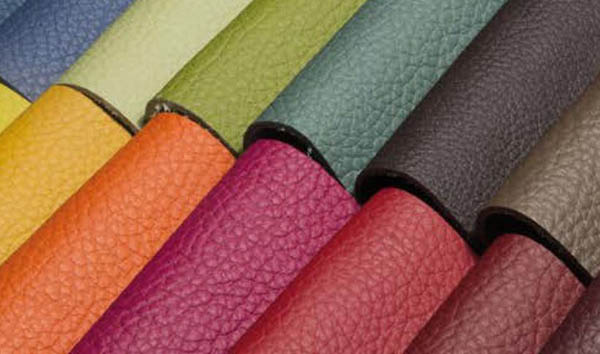
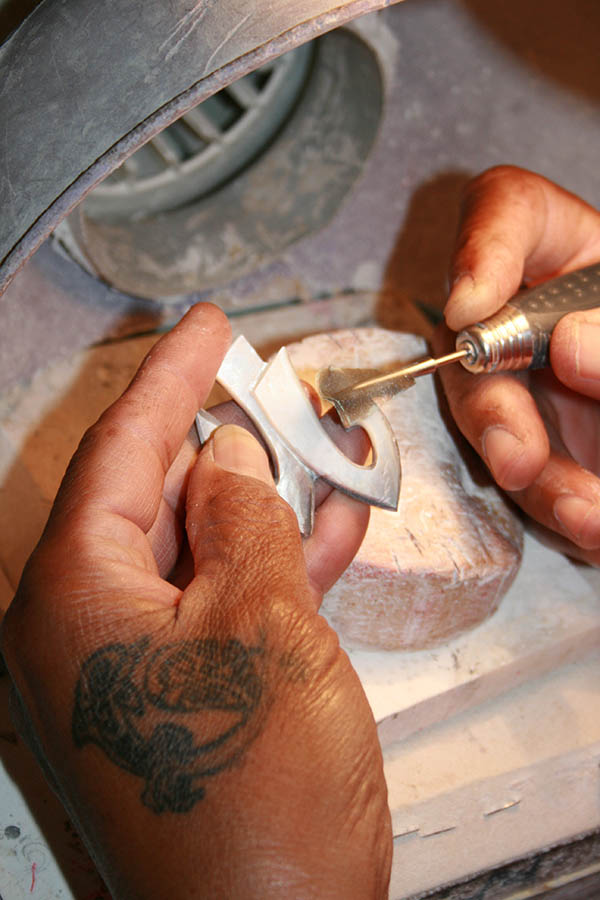
Engraved mother-of-pearl, shells and Megalodon teeth
Carcharocles megalodon, an impressive ancestor of the great white shark, was around 18 metres long! The fossilised teeth of this ancient giant of the seas can measure up to 20 cm long. A deposit of several thousand teeth was discovered at a depth of 500 metres off the coast of New Caledonia. Such giant teeth make unusual and intriguing artworks, polished, engraved, made into a pendant or framed. Engravings on mother-of-pearl are an art form going back to the 19th century and the days of the penal colony, when convicts engraved shells in secret to be smuggled to local buyers as a stealthy way of making a little money.
Soapstone
Soapstone is fairly difficult to quarry but is soft and easy to carve. Local artisans use it to create a variety of artworks, including small-scale sculptures portraying traditional huts and doorposts or New Caledonian plant and wildlife species. Pouébo, on the East Coast of the North Province, is famed for its soapstone statuettes, which have proved very popular with tourists visiting the Main Island.
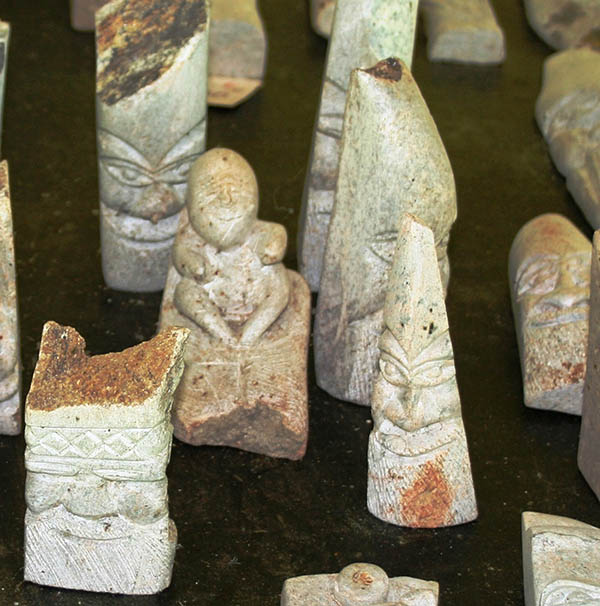
Bamboo engravings
Intricately engraved bamboos are just one of the fascinating art forms mastered by bygone Kanak craftsmen and they played a key role in recording important events in an oral culture. Engraved canes collected in the late 19th century date back to the time Europeans first arrived in New Caledonia and show scenes of historic and ceremonial significance or everyday scenes: markets, colonial houses, fishing, building huts and work in the fields. A number of local artisans create and sell decorative items inspired by these historic artefacts: contemporary bamboo engravings, prints and paintings.
Tapa barkcloth
Tapa is the name given to the delicate, intricately decorated cloth made from the bark of the paper mulberry tree. Tapa is traditionally made by women; strips of beaten bark are sown together to make cloths of different sizes, which are then decorated with hand-painted geometric designs. Tapa is a key art form in Wallis and Futuna but is also found throughout Oceania. Tapa cloth can be used to make everyday objects: wallets, card cases, pouches and handbags...
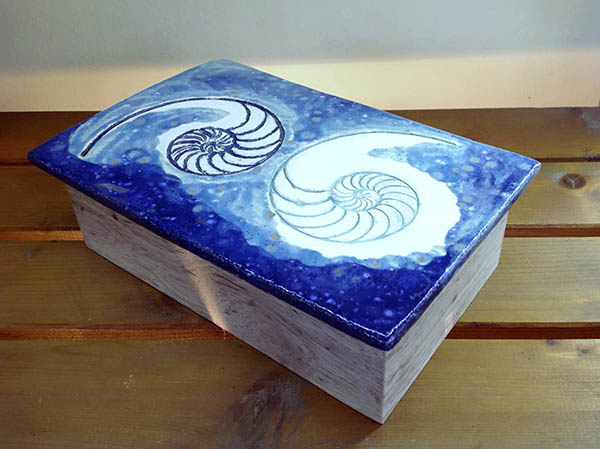
Pottery and ceramics
Raw clay comes to life in the expert hands of local artisans: skilled knowledge of techniques for shaping clay, by hand or using a potter’s wheel, and a mastery of firing processes are crucial when transforming raw material into fine tableware or decorative artworks: earthenware, stoneware, glazed, unglazed or painted. The ancient tradition of Lapita pottery lives on in New Caledonia !
Gemstone cutting
A gemcutter is someone who cuts, shapes, and polishes minerals, stones and precious or semi-precious gemstones so they can be used to embellish jewellery and artworks. New Caledonia's gemcutters work in jade, serpentine, fossilised conch shell and dunite. All gems are polished to smoothly rounded forms by progressive abrasion using finer and finer grits of harder substances, a process known as tumbling. Gemstones can be cut en cabochon or facetted, depending on the desired effect and the nature of the material.
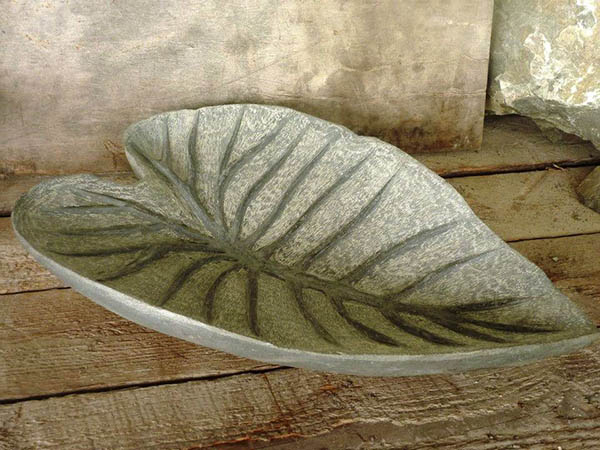
Where to buy our products
Here is a non-exhaustive list of places where you can browse and buy ARDICI products and, in many cases, meet the people who create them !
South Province
Ardici artisan workshops open to the public
Again & Again

Valérie ERRE makes and markets furoshiki fabric bags in her workshop/boutique at the top end of Place des Cocotiers.
51 rue jean Jaurès, Centre-ville, Nouméa, South Province
Open Tuesday to Friday 11 a.m. to 5 p.m.
 23.72.30
23.72.30- This email address is being protected from spambots. You need JavaScript enabled to view it.


Art Pacific
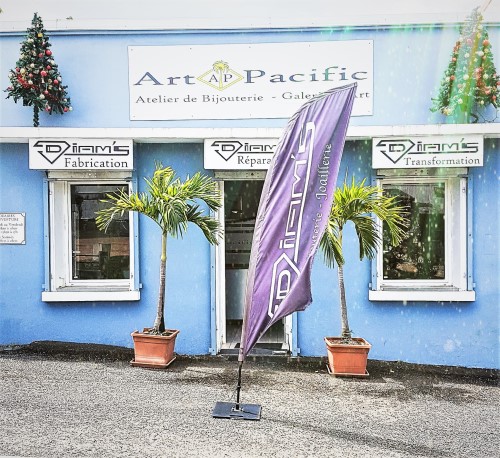
Dominik DOLBEAU is based in Bourail and designs and crafts handmade jewellery. He uses CAD software for some of his designs, and laser cutting techniques for some items of jewellery.
106 rue Thuret, Bourail, Province Sud
Open Tuesday to Friday 8.30 a.m. to 11.30 a.m. & 1.30 p.m. to 5 p.m. & Saturday 8.30 a.m. to 11.30 a.m.
 44.99.12
44.99.12- This email address is being protected from spambots. You need JavaScript enabled to view it.

Atelier C3D
Stéphane Roturier uses 3D printing to create likenesses of real people which he then paints by hand.
Truly unique one-of-a-kind gifts! Stéphane can make mini models of your friends and family, capture your most memorable moments... weddings, anniversaries, Saint Valentine's Day, communions, etc. And, on request, he can also create scenes with a favourite setting or decor. Find out more with a visit to his studio/boutique.
81 rue des Thazards, Boulari covered market, Mont-Dore, South Province
Open Wednesday to Saturday 7.45 a.m. to 1 p.m., Sunday 7.45 a.m. to midday and by appointment up to 4 p.m.
 90.80.22
90.80.22- This email address is being protected from spambots. You need JavaScript enabled to view it.


Aca.ry
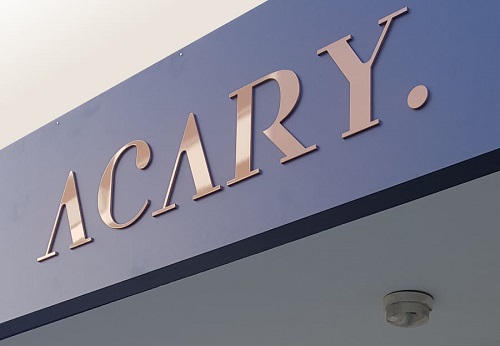
Yovenn ROCH is a craft jewellery designer. He creates, fashions and repairs jewels made from precious metals (gold, silver, platinum) and set with precious and semi-precious stones, diamonds or cultured pearls from Tahiti, China or Japan.Le Village, 35 Avenue FOCH, centre ville, Nouméa, Province Sud
10 rue du Docteur Guegan, Quartier Latin, Noumea
Open Tuesday to Friday 9 a.m. to 1.30 p.m. & 2.30 to 5.30 p.m. & Saturday morning from 9 a.m. to midday. Closed on Mondays.
 83.20.98
83.20.98- This email address is being protected from spambots. You need JavaScript enabled to view it.

Anutea
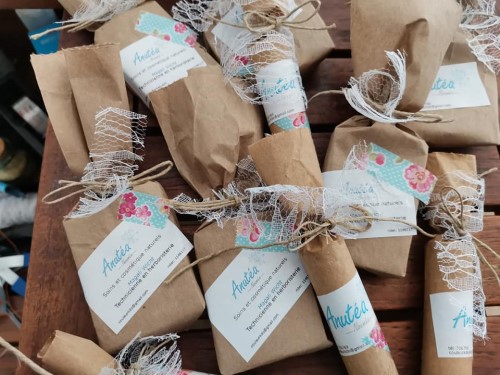
Magali WICHT creates and sells a range of natural wellbeing and skincare products: creams, balms, massage oils, shampoos and conditioners, home fragrances and mosquito repellent products.
56 Rue Sébastopol, Nouméa, Province Sud
Open Tuesday to Friday 9 a.m. to midday and 2 p.m. to 5.30 p.m. & Saturday 9 a.m. to midday.
 70.67.69
70.67.69- This email address is being protected from spambots. You need JavaScript enabled to view it.

Atelier C'Ô Soleil
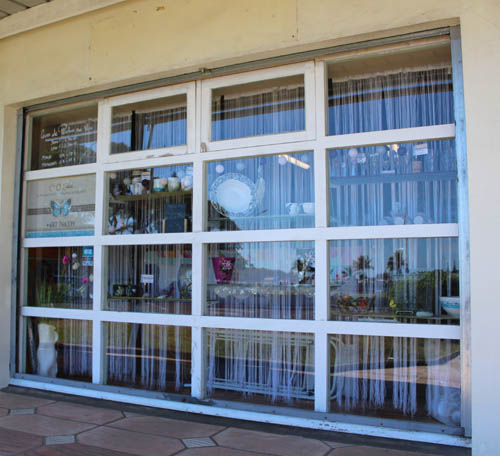
Corinne Govan paints and decorates glass and porcelain items. Her colourful designs are on show at her studio in Maison des Artisans craft centre in the afternoons and, in the morning, you can see her designs at Nouméa’s main market in Baie de la Moselle.
Studio 14- Maison des Artisans
12, Avenue James COOK – Nouville – Nouméa, South Province
Open in the afternoon
 76.63.39
76.63.39- This email address is being protected from spambots. You need JavaScript enabled to view it.

Atelier Créargile
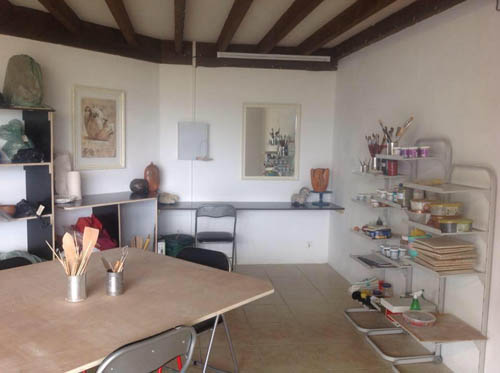
Pottery and ceramics studio where you’ll find one-of-a-kind and limited series designs by Martine Ageorges, and where she also gives lessons for adults and kids.
Studio 13 - Maison des artisans
12, avenue James COOK, Nouville, Nouméa, South Province
Open Monday 2 to 5 p.m., Tuesday & Wednesday 2 to 8 p.m
 74.07.22
74.07.22- This email address is being protected from spambots. You need JavaScript enabled to view it.

Atelier « Domina cadre » et « Dom Encadrement »
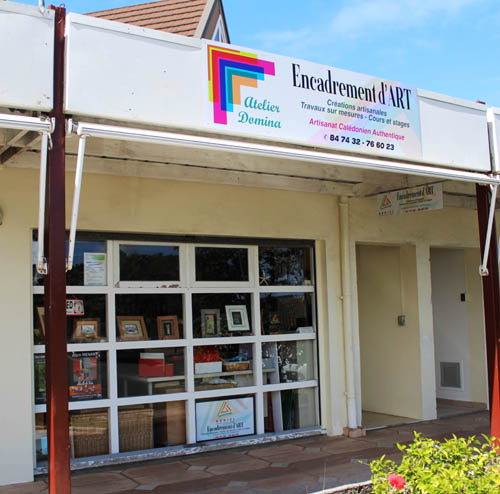
The place to find the superbly designed frames made by Dominique Guinguin of “Domina Cadre” and by Dominique Haques of “Dom Encadrement” to embellish artworks by local artists. The two expert craftswomen will be delighted to help and advise you regarding all your professional framing and cartonnage requirements.
Studio 11 - Maison des Artisans
12, avenue James COOK, Nouville, Nouméa, South Province
Open Monday to Friday 9 a.m. to midday & 1 to 5.30 p.m. & Saturday 9 a.m. to midday
L'atelier Hue Cocotte !
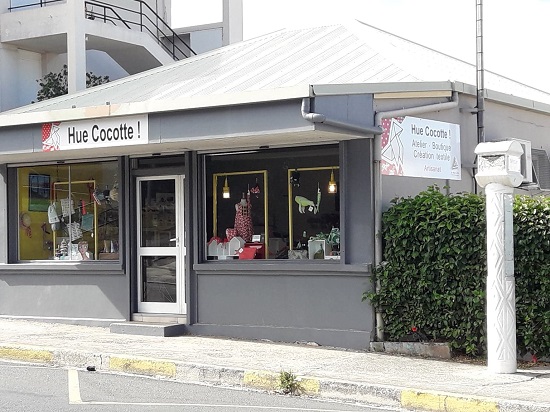
Caroline makes clothing and accessories for women and children, together with decorative articles for homes and bedrooms. Her designs, full of colour, sparkle and fun, are on display at local markets and in her studio/boutique.
68 rue Auguste Bénébig, Vallée des Colons, Nouméa,South Province
Open 8 a.m. to 6 p.m. & Saturday 8:30 a.m. to midday Closed on Mondays and Sundays
 53.89.25
53.89.25- This email address is being protected from spambots. You need JavaScript enabled to view it.


« Né d'argile » Studio
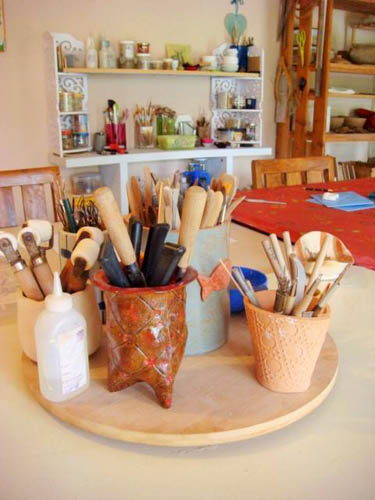
Call 24 hours ahead and Marie-Hélène Bize will welcome you to her studio to browse her ceramics and jewellery designs. She also gives pottery classes.
Villa 1101, Nogouta 1, Païta, South Province
 77.91.94
77.91.94- This email address is being protected from spambots. You need JavaScript enabled to view it.


Braidly Lily
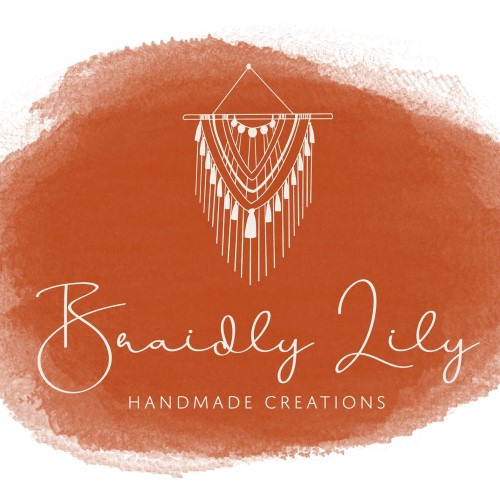
Aurélie PRINCE makes macramé homeware items and fashion accessories in her workshop.
Val Plaisance, Nouméa, South Province
Open Monday to Friday 8 a.m. to 7 p.m. & Saturday 8 a.m. to 5 p.m.
 72.39.88
72.39.88- This email address is being protected from spambots. You need JavaScript enabled to view it.


CJL Jewellery - Le Joaillier
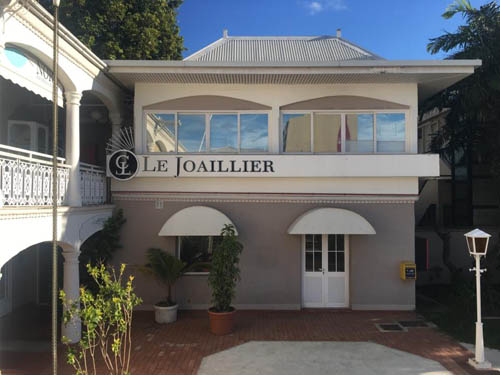
Boutique jewellery craftsman Chris Leeks welcomes you to his studio right in the heart of Nouméa where he creates unique jewellery using precious materials. Chris also creates exclusive pieces to order and is skilled in restoring and remodeling jewellery.
Le Village, 35 Avenue FOCH, Downtown, Nouméa, South Province
Open Monday to Friday 8 a.m. to 5 p.m.
 51.96.18
51.96.18- This email address is being protected from spambots. You need JavaScript enabled to view it.


CKOASA
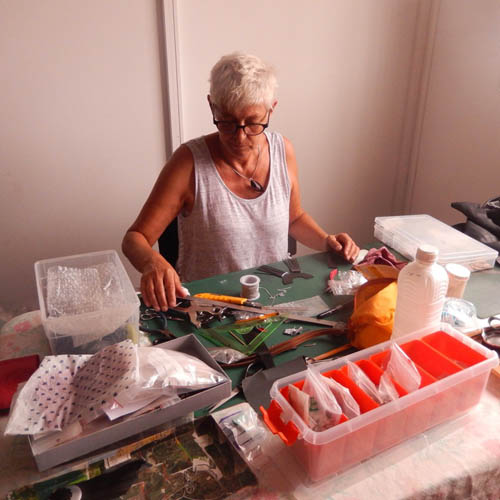
Catherine Thomas, creator of the CKOASA jewellery range, designs environmentally friendly collections: necklaces, bracelets and earrings fashioned from recycled materials such as rubber from inner tubes and aluminium from cans to create light, elegant and easy to wear jewellery.
9, rue D’AUSTERLITZ, Downtown, Nouméa, South Province
Open Monday to Friday and by appointment
 76.48.83
76.48.83- This email address is being protected from spambots. You need JavaScript enabled to view it.


Dans Ma Bulle
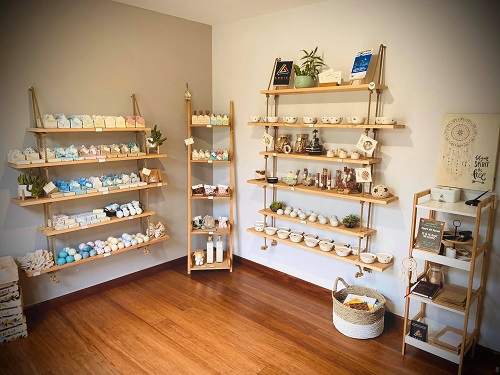
Dans Ma Bulle is a craft soap business making a range of beauty care and everyday products from locally produced natural ingredients such as honey, beeswax and oil distilled from candlenut, tamanu and niaouli trees.
31 rue Jean Ohlen, Vallée des Colons
Dans Ma Bulle is open on Mondays, Tuesdays & Fridays from 4 to 6.30 p.m. or by appointment - just call 729 789.
 72.97.89
72.97.89- This email address is being protected from spambots. You need JavaScript enabled to view it.

Distillerie de Boulouparis
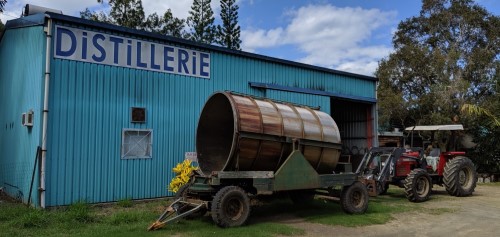
Jordane LATOUR is a biochemist and has a family business making essential oils, plant oils, floral waters, soaps, skincare products, mosquito repellents and balms...
RT1 sortie village, Boulouparis, Province Sud
Open Monday To Sunday 8 a.m. to 6 p.m.
 46.44.60
46.44.60- This email address is being protected from spambots. You need JavaScript enabled to view it.


Galerie Naturami
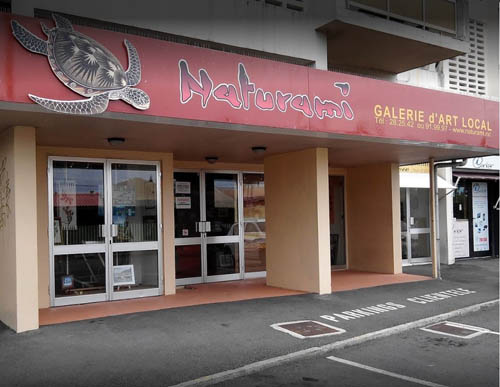
Founded in 1997 by dedicated New Caledonian artists Anne-Marie d'Anglebermes and Patrick Duffieux, NATURAMI is both a studio and a shop. The two artists showcase and sell imaginative and original works in their own distinctive styles, inspired by New Caledonia’s landscapes and the rich heritage of local legends.
81, rue CHARLEROI, Vallée des Colons, Nouméa, South Province
Open Tuesday to Saturday 8.30 to 11.30 a.m.
Kim et Stella Design
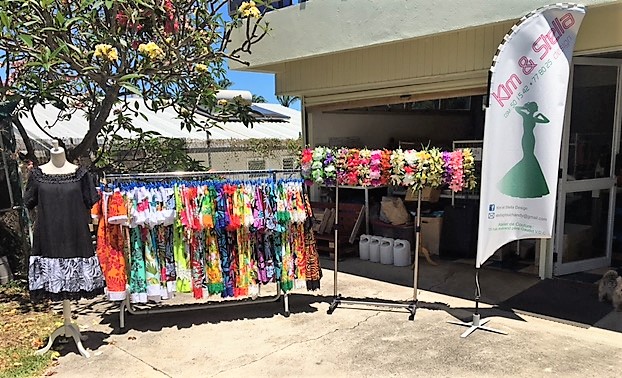
Kim MANATE and Stella PROUCHANDI are dressmakers and create their own fabric designs, specialising in Polynesian-inspired fashion for men, women and children, including accessories such as bags.
15 rue Révérend Père Gaudet
Open Tuesday to Friday 9 a.m. to 5 p.m. Closed on Monday, Saturday, Sunday and public holidays.
Koghis Peinture
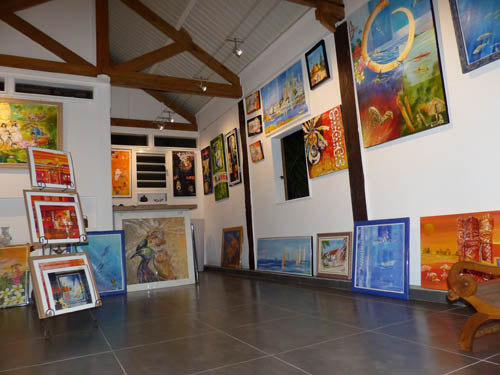
Aimé Nangard opened his studio/gallery in 2015 in a lush green setting at Monts Koghis. He will be delighted to show you his paintings, which glow with vibrant colours and fuse contemporary motifs with traditional themes reflecting his fascination for Oceanian art and Kanak and Papuan culture and customs.
203, route du Mont KOGHIS, Dumbéa, South Province
Open by appointment, please call ahead
Laser Art Pacific
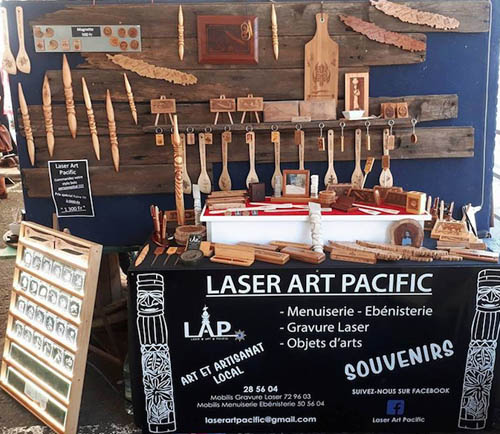
Laser Art Pacific specialises in engravings on wood, glass, plexiglass and mother-of-pearl. Jérome and Bruno are also expert carpenters and cabinetmakers, designing personalised trophies, New Caledonian artworks (totems, gaïac wood doorposts, arrows, carved swords...) and everyday objects: pens, coasters, chopping boards, etc. Exclusive, high quality local souvenirs handcrafted in New Caledonia.
Rue Martial DANTON, ZI de Yahoué, Normandie, Nouméa, South Province
Open Monday to Friday 8 a.m. to 5 p.m. & Saturday 8 a.m. to midday
Les Cent Ciels de June
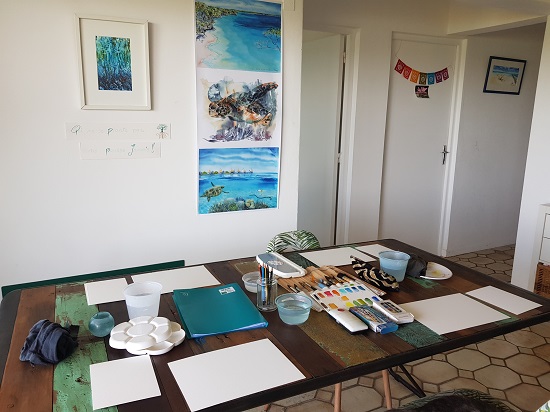
In her Cent Ciels de June studio, June creates delicately vibrant watercolours of New Caledonian landscapes, available as numbered and framed art prints, posters and postcards. June is also happy to paint your favourite landscapes to order.
Her studio in Ouémo is open during the week by appointment and she holds watercolour painting classes for adults every Tuesday afternoon and evening.
You will also find June’s work on display in Coccoloba arts & crafts store in Noumea and at the weekend at the Moselle Market.
 95.94.00
95.94.00- This email address is being protected from spambots. You need JavaScript enabled to view it.

Les copeaux du caillou
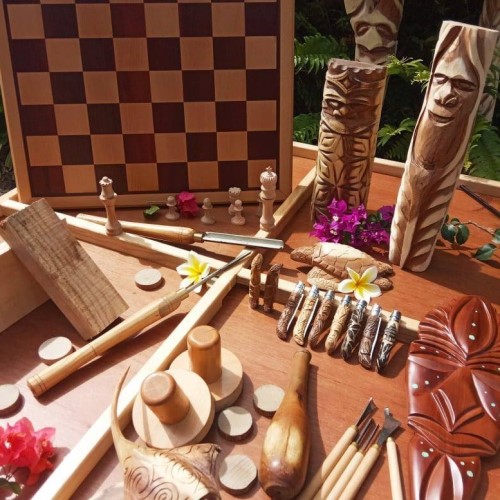
Workshop shared by 3 artisans working in the field of carpentry and wood carving.
21 Rue Nobel, Ducos, South Province
On appointment
Work & designs by ARDICI artisans featured in this shop :
BB SCULPTURE
R’WOOD
SCULPTEUR SHALUM’
Les Sables émouvants
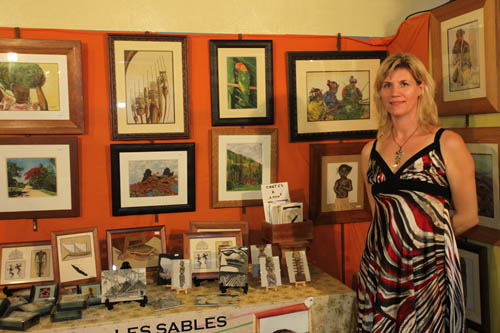
Call Chantal Dubois 24 hours in advance to visit her studio and see her unusual and delightful sand paintings.
9, rue de ROCHEFORT, Rivière Salée, Nouméa, South Province
 81.97.20
81.97.20- This email address is being protected from spambots. You need JavaScript enabled to view it.

Ma soeur Antoinette
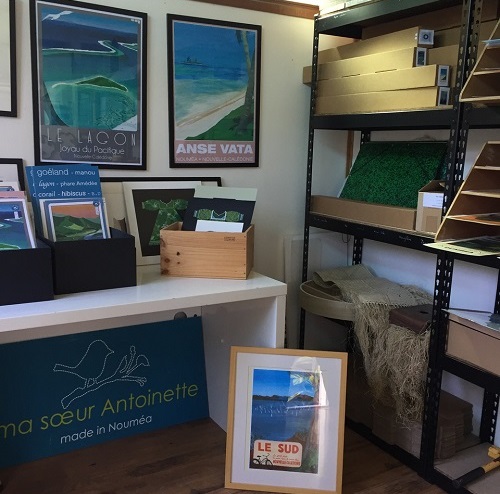
Ma soeur Antoinette proposes besides the printings, the engravings and original paintings. It is possible to place at her orders of paintings. Workshop visits by appointment.It is possible from Monday to Friday from 9 am till 6 pm.
5 rue James Cook, Faubourg Blanchot, Nouméa, South Province
Please call ahead to visit the workshop.
 75.42.15
75.42.15- This email address is being protected from spambots. You need JavaScript enabled to view it.

Outsider Knives NC
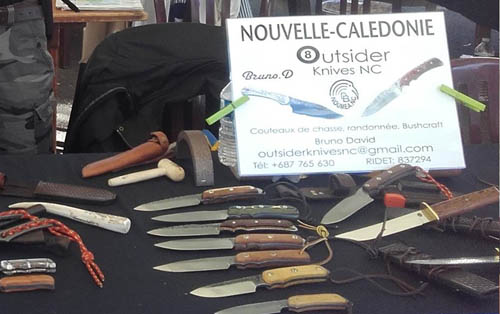
Quality knives handcrafted in New Caledonia. Workshop visits by appointment.
Rue Martial DANTON, ZI de Yahoué, Normandie, Nouméa, South Province
Please call ahead to visit the workshop.
 76.56.30
76.56.30- This email address is being protected from spambots. You need JavaScript enabled to view it.

Pierre et Patrimoine
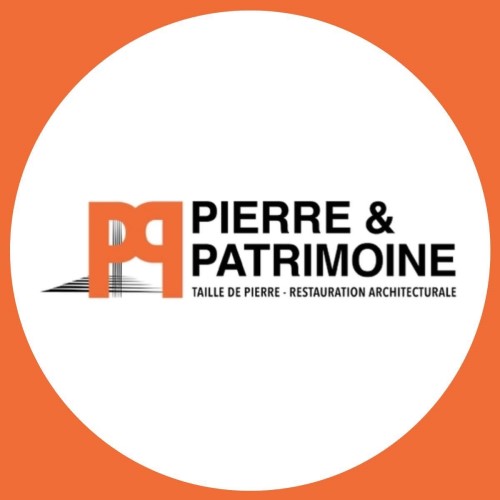
Jonathan CHOUVENC is a stonemason specialising, amongst other things, in architectural restoration. Jonathan and his business partner Bernard work in marble, engraving and stone cutting. They are also skilled at creating ornamental, interior decoration and architectural features using local stone. Jonathan and Bernard design and build a wide range of structures including pool surrounds, stairs, benches, fountains, BBQs, fireplaces, columns, door posts or pillars and commemorative stones...
Route vallée de la haute caricouyé, Mont-Mou, Païta, Province Sud
Open Monday to Wednesday 7 a.m. to 4 p.m. & Thursday 7 a.m. to 5 p.m. & Friday 7 a.m. to 3 p.m.
 50.38.08
50.38.08- This email address is being protected from spambots. You need JavaScript enabled to view it.

Studio Del'Art
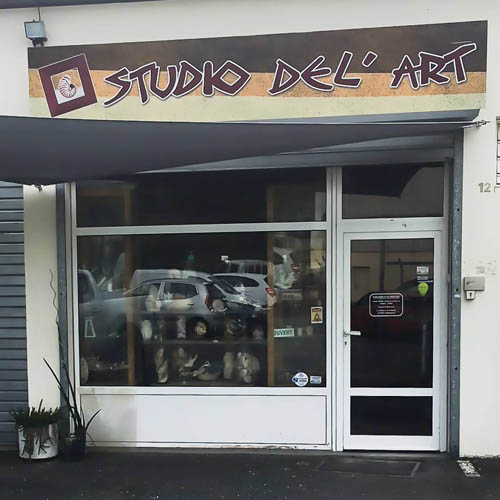
Delphine Tanti welcomes you to her studio/boutique to show you her wide range of handcrafted decorative items. She designs sand pictures embellished by nautilus shells, tiny wooden or ceramic sculptures and also ceramics inspired by marine wildlife species endemic to New Caledonia.
12, rue Jean-Pierre LAPOUS, Doniambo, Nouméa, South Province
Workshop open by appointment in the morning. Open Monday, Tuesday, Thursday & Friday 1:30 to 5:30 p.m. - no appointment needed
 79.88.29
79.88.29- This email address is being protected from spambots. You need JavaScript enabled to view it.

V.I.P Vivre un instant parfumé
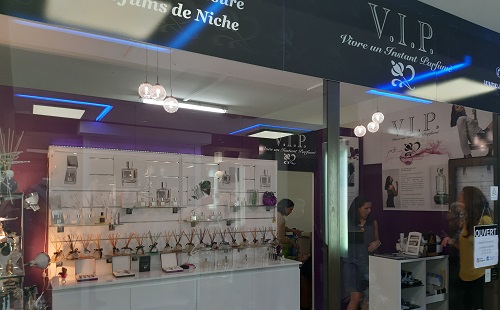
Eaux de toilette, eaux de parfum, perfumed hair mists, fragrance diffusers, home fragrances... You’ll find all the delicious scents created by perfume designer Marion HABAULT, New Caledonia's only homegrown “nose”, in her elegant and intimate boutique in Port Plaisance shopping mall, next to the shoemaker’s shop. Customers can also glimpse Marion’s impressive perfumer's organ in the design studio next to her shop. Marion will be happy to tell you how she creates her scents with love and patience, and to advise you on perfumes.
Galerie Port Plaisance, Baie des Pêcheurs, 10 rue Jules Garnier, Noumea
Open Tuesday to Friday 10 a.m. to midday and 2.30 to 6.00 p.m. Closed Sunday & Monday.
 24.94.22
24.94.22- This email address is being protected from spambots. You need JavaScript enabled to view it.


Stores providing Retail outlets
Retail outlet at Ambiance et Styles
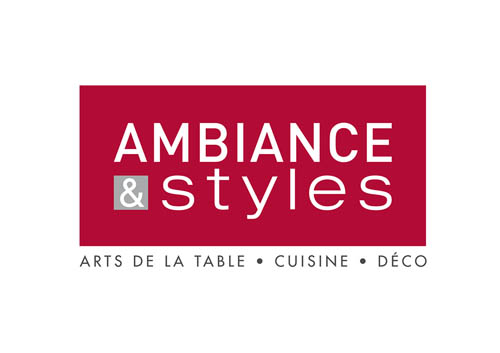
Latin Quarter store specialising in table art, kitchenware and ornaments which stocks lagoon designs by Caroline Desgrées de Loû.
20, rue de Auguste Brun, Latin Quarter, Nouméa, South Province
Open Monday to Saturday 8 a.m. to 6 p.m.
Work & designs by ARDICI artisans featured in this shop :
MA SŒUR ANTOINETTE
Retail outlet at Amarok NC
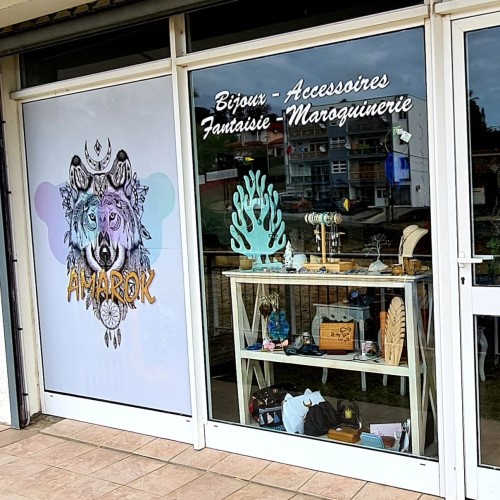
Amarok sells a range of costume jewellery, leather goods, ornaments, decorative objects, rolled stones, rough or carved, and esoteric accessories but also local handicrafts with its jewellery and fine stone decoration creations.
BP 857, 84 rue victor Tant, Apartment building BCI, Bourail, South Province
Open Tuesday to Friday 8 a.m. to midday and 2 p.m. to 5 p.m. & Saturday 8 a.m. to 11 a.m.
 50.02.84
50.02.84- This email address is being protected from spambots. You need JavaScript enabled to view it.

Work & designs by ARDICI artisans featured in this shop :
Brouss’Art Gravure
CRS.NC
Inspiration Nature NC by Alex
LA PATTE DE PIM'S
Nimpy NC
Retail outlet at Aqua
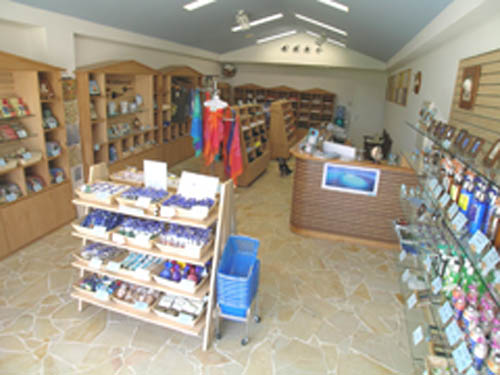
Store selling souvenirs designed specifically to appeal to Japanese visitors, located at La Promenade Complex on Anse Vata: essential oils, cosmetics, fabric designs by a number of local artisans.
107, promenade Roger Laroque, Anse Vata, Nouméa, South Province
Open every day from 10 a.m. to 7 p.m.
Work & designs by ARDICI artisans featured in this shop :
CAMICOO
LES TOILES DES Z’ILES
STUDIO DEL ART
Retail outlet at Biomonde
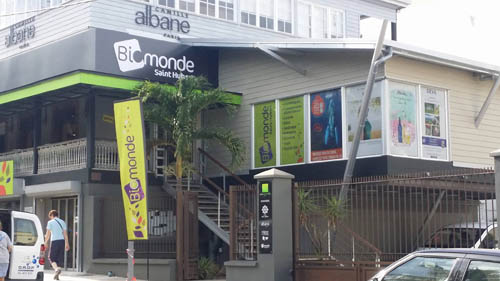
New Caledonia’s very first organic store committed to providing a community retail experience based on mutual respect. The two-floor store on Place des Cocotiers gives pride of place to local artisans and quality is a key priority.
Carré Saint Hubert, Place des Cocotiers, Downtown, Nouméa, South Province
Open Monday to Friday 8 a.m. to 6 p.m. & Saturday 9 a.m. to midday
 25.95.25
25.95.25- This email address is being protected from spambots. You need JavaScript enabled to view it.


Work & designs by ARDICI artisans featured in this shop :
MA SŒUR ANTOINETTE
MY PACIFIC WOOD LIGHT
PUKEKO.NC
RESSAC
TONY C
WARNA
Retail outlet at Caledo Livres
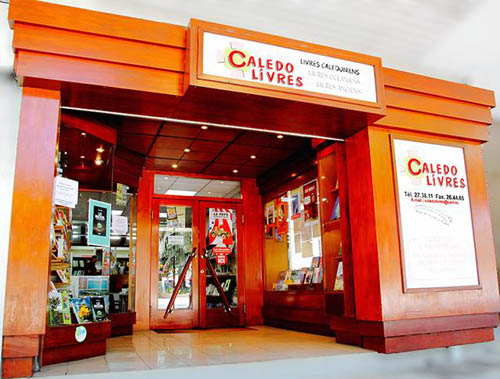
Calédo Livres bookstore stocks a wide range of books published in New Caledonia.
21 ter, rue Jean JAURES, Downtown, Nouméa, South Province
Open Tuesday to Friday 8.30 a.m. to 5 p.m. & Saturday 8.30 a.m. to 1 p.m.
 27.38.11
27.38.11- This email address is being protected from spambots. You need JavaScript enabled to view it.

Work & designs by ARDICI artisans featured in this shop :
MA SŒUR ANTOINETTE
LES CENTS CIELS DE JUNE
Retail outlet at Compagnie du vrac
Bulk grocery selling a wide range of package-free bulk foods and zero waste products (shampoo, soaps, cotton bowl covers...).
5 rue Gabriel Busiau, South Province
Open Monday to Saturday
MONDAY: 2.30 - 6 p.m.
TUESDAY: 10 a.m. to 12.30 p.m. & 2.30 - 6 p.m.
WEDNESDAY: 9.30 a.m. to 12.30 p.m. & 2.30 - 6 p.m.
THURSDAY: 2.30 - 6 p.m.
FRIDAY: 9.30 a.m. to 12.30 p.m. & 2.30 - 6 p.m.
SATURDAY: 9.30 a.m. to 12.30 p.m. & 3 - 6 p.m.
 76.58.98
76.58.98- This email address is being protected from spambots. You need JavaScript enabled to view it.

Work & designs by ARDICI artisans featured in this shop :
BAEBAO
Retail outlet at Clavinova

Store selling musical instruments and sound equipment.
33 rue Georges Clémenceau, Nouméa, Province Sud
Open Monday to Friday 9 a.m. to 5.45 p.m. & Saturday 9 a.m. to midday and 2 p.m. to 5 p.m.
 28.89.90
28.89.90- This email address is being protected from spambots. You need JavaScript enabled to view it.


Work & designs by ARDICI artisans featured in this shop :
HEITAMA
Retail outlet at Curl Coiffure
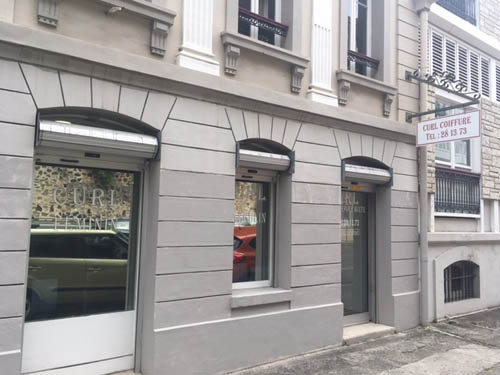
Hairstyling salon stocking handmade cosmetics by Peggy Chaniel.
30, boulevard Vauban, Nouméa, South Province
Work & designs by ARDICI artisans featured in this shop :
LADY BEE COSMETIQUES
Retail outlet at Enzo Enzo
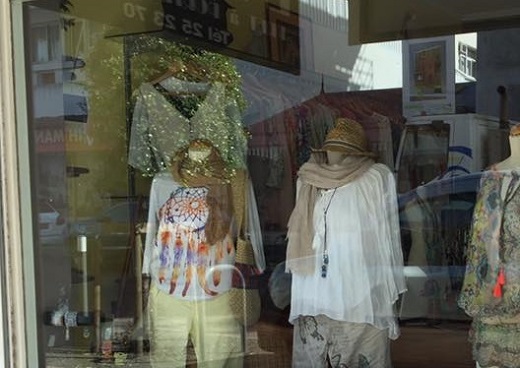
Fashion & accessories store in the Latin Quarter...
20, rue auguste brun, quartier latin
Open Tuesday to Friday 9 a.m. to 5.30 p.m. & Saturday 9 a.m. to midday.
 25.23.70
25.23.70- This email address is being protected from spambots. You need JavaScript enabled to view it.

Work & designs by ARDICI artisans featured in this shop :
BIG ISLAND
Retail outlet at Epicerie Bio de Robinson
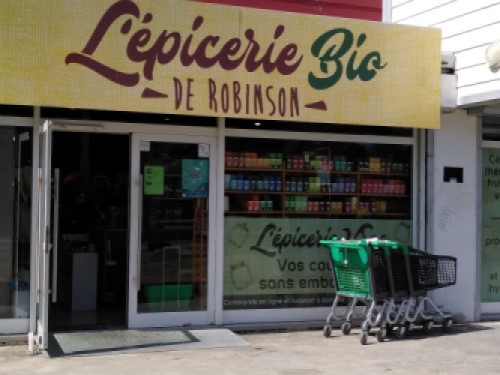
Retail sale of organic products.
48 rue Victorin Boewa ROBINSON
Open Monday to Friday 8:30 a.m. to 6 p.m. & Saturday 8:30 a.m. to 5.30 p.m.
 29.82.81
29.82.81- This email address is being protected from spambots. You need JavaScript enabled to view it.


Work & designs by ARDICI artisans featured in this shop :
BAEBAO
Retail outlet at FNAC

Fnac department store in downtown Nouméa stocks products by Caroline Desgrées Du Loû.
34, rue de l’Alma, Downtown, Nouméa, South Province
Open Tuesday to Friday 8.30 a.m. to 6 p.m. & Saturday 8.30 a.m. to 7.30 p.m.
Work & designs by ARDICI artisans featured in this shop :
MA SŒUR ANTOINETTE
Retail outlet at Folissime Coiffure
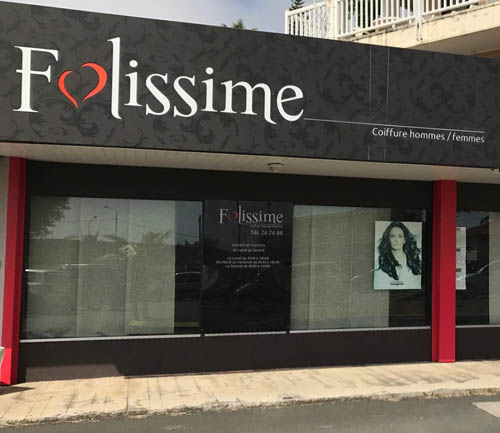
Find the “Unique et Natural” range of handcrafted beauty care products at this charming, friendly hairstyling salon for men, women & children.
3, rue Gustave FLAUBERT, Baie de l'Orphelinat, Nouméa, South Province
Open Tuesday to Friday 8 a.m. to 6 p.m. & Saturday 8 a.m. to 5 p.m.
 26.26.88
26.26.88- This email address is being protected from spambots. You need JavaScript enabled to view it.

Work & designs by ARDICI artisans featured in this shop :
UNIQUE ET NATUREL COSMETIQUES
Retail outlet at Funky Fripe
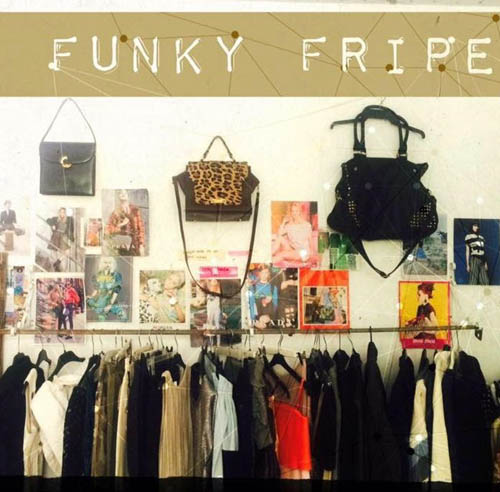
Located near Place des Cocotiers, laidback vintage fashion store Funky Fripe welcomes you to a paradise of colourful retro gear rocking the latest trends. The store stocks ranges of second-hand clothing, shoes, accessories and jewellery, including designs by Pierrette Faure.
33, rue Jean Jaurès, Downtown, Nouméa, South Province
Open Monday noon to 4.45 p.m., Tuesday to Friday 9.45 a.m. to 4.45 p.m. & Saturday 9.45 a.m. to 4 p.m.
Work & designs by ARDICI artisans featured in this shop :
PETITE PIERRE
Retail outlet at Institut Zenyah

Beauty salon
611 Avenue des 2 Baies 98874 Pont des Français, South Province
Open Monday to Friday 9 a.m. to 7.30 p.m. & Saturday 8 a.m. to 4 p.m.
 28.60.60
28.60.60- This email address is being protected from spambots. You need JavaScript enabled to view it.

Work and designs by ARDICI artisans featured at this venue :
LE STAND D’IRENE
Retail outlet at Joyan n'c
In addition to a wide range of fresh groceries, deli treats and takeaway specialities & coffees, Joyan N’C also sells locally crafted artisan products.
69 rue Gabriel Laroque, Val Plaisance, Noumea
Open Monday, Tuesday & Thursday 7.30 a.m. to 12.30 p.m./ 3.30 to 6 p.m. Wednesday & Friday non-stop 7.30 a.m. to 9 p.m. Saturday morning 7.30 a.m. to 12.30 p.m.
Work and designs by ARDICI artisans featured at this venue :
BAEBAO
DANS MA BULLE
NIRINA CREA
PETITE PIERRE
Retail outlet at Epicerie Vrac
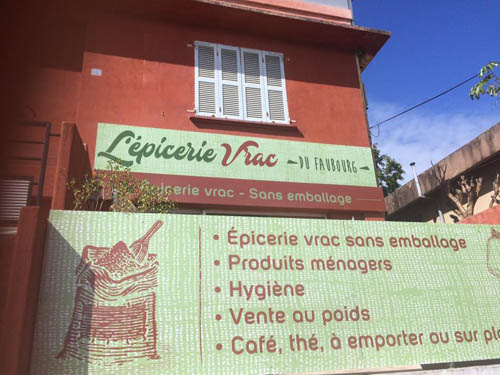
Zero packaging at this grocery store, where you can buy the exact amount you need - food, personal care and household products. Several environmentally-aware ARDICI artisans sell their products here.
89, route du Port Despointes, Faubourg Blanchot, Nouméa, South Province
Open Monday to Saturday 9 a.m. to 6 p.m.
Work & designs by ARDICI artisans featured in this shop :
BAEBAO
LADY BEE COSMETIQUES
PUKEKO
RESSAC
Retail outlet at As de Trèfle
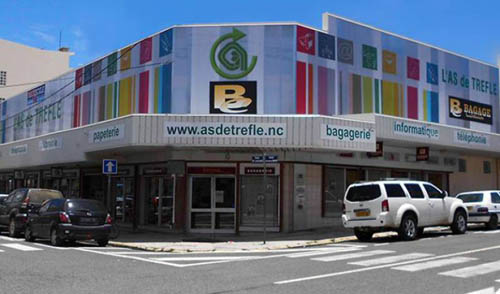
As de Trèfle bookstore, established in 1978, is a real local institution and has two stores in Nouméa.
13, rue du Dr LESCOUR, Latin Quarter, Nouméa, South Province
Latin Quarter store open Monday to Friday 8 a.m. to 6 p.m. & Saturday 8 a.m. to 5.30 p.m.
202, rue GERVOLINO, Magenta, Nouméa, South Province
Magenta store open Monday to Saturday 8 a.m. to 6 p.m.
 27.82.41 Latin Quarter
27.82.41 Latin Quarter 35.28.50 Magenta
35.28.50 Magenta- This email address is being protected from spambots. You need JavaScript enabled to view it.


Work & designs by ARDICI artisans featured in this shop :
ASA MARIA CHIPMAN
KOGHIS PEINTURE
MA SŒUR ANTOINETTE
LES CENTS CIELS DE JUNE
Retail outlet at La savonette
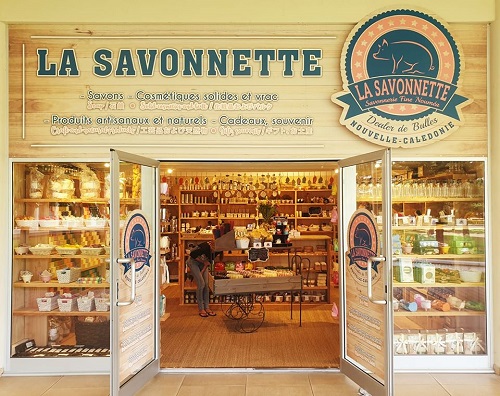
La Savonnette sells fragrant all-natural Marseille and decorative soaps as well as novel skincare and household products. The shop also stocks handmade craft soaps from local “Dans ma Bulle” range, also available from their speciality store.
Promenade Roger Laroque/ Complexe Hilton / Anse Vata Nouméa
Open Monday to Sunday 9 a.m. to 7 p.m.
Work & designs by ARDICI artisans featured in this shop :
DANS MA BULLE
Retail outlet at Laser Art Pacific
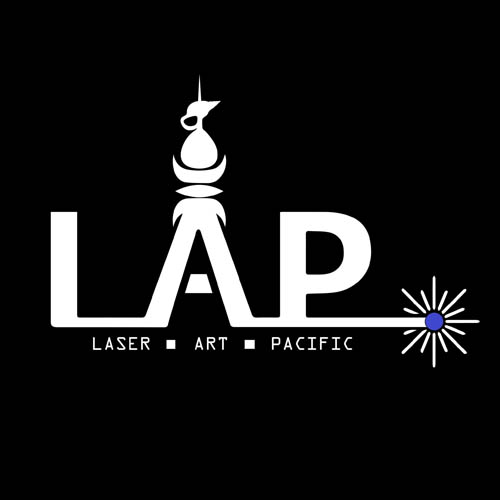
ARDICI member Laser Art Pacific also provides a retail outlet for other artisans at their Normandie workshop.
Rue Martial Danton, ZI de Yahoué, Normandie, Nouméa, South Province
Open Monday to Friday 8 a.m. to 5 p.m. & Saturday 8 a.m. to midday
 28.56.04 / 72.96.03 et 50.56.74
28.56.04 / 72.96.03 et 50.56.74- This email address is being protected from spambots. You need JavaScript enabled to view it.


Work & designs by ARDICI artisans featured in this shop :
AUTOUR DE L'ARBRE
LASER ART PACIFIC
L'ATELIER DE VAL
MY PACIFIC WOOD LIGHT
TIAOU MELEM
TIAOU NOEMIE
Retail outlet at Atelier du Bien-Être
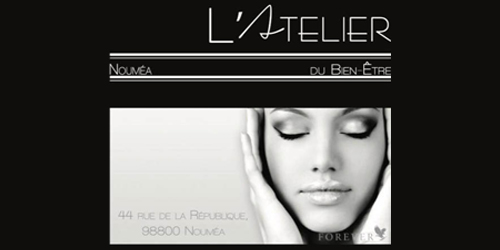
Beauty care centre stocking handcrafted jewellery designed by Pierrette Faure.
44, rue de la République, Downtown, Nouméa, South Province
Open Tuesday, Wednesday & Friday 9 a.m. to 7.30 p.m. Thursday 9 a.m. to 8 p.m., Saturday 9 a.m. to 5 p.m.
Work & designs by ARDICI artisans featured in this shop :
PETITE PIERRE
Retail outlet at Librairie Michel Ange

Michel Ange bookstore, located in the Motor Pool neighbourhood, stocks a wide range of stationary, newspapers & magazines, plus a host of New Caledonian souvenir gifts.
93, route de l’Anse Vata, Nouméa, South Province
Open Monday to Friday 7 a.m. to 7 p.m., Saturday 7.30 a.m. to 7 p.m. & Sunday 7.30 a.m. to midday
Work & designs by ARDICI artisans featured in this shop :
LASER ART PACIFIC
MA SOEUR ANTOINETTE
ASA MARIA CHIPMAN
Retail outlet at Need It
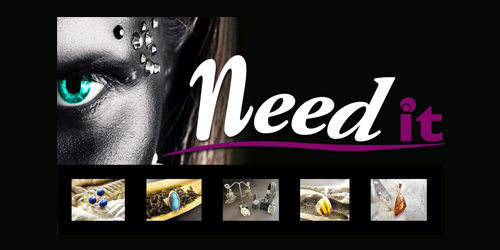
Need It, located in downtown Nouméa, has been designing jewellery since 2008. The store stocks a wide range of jewellery inspired by traditional styles from all over the world, including silver jewellery set with semi-precious stones and macramé jewellery. A great shop to find pieces by local and international designers.
38 rue Verdun, Downtown, Nouméa, South Province
Open Tuesday to Friday 9.30 a.m. to 5.30 p.m. & Saturday 9 a.m. to 5 p.m.
 27.84.46
27.84.46- This email address is being protected from spambots. You need JavaScript enabled to view it.


Work & designs by ARDICI artisans featured in this shop :
ARTS & PIERRE
MATHIEU TARDY
Retail outlet at Palm Beach Curios
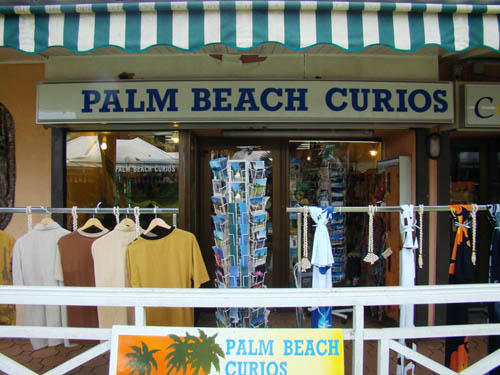
Souvenir and gift shop which stocks a selection of products by our local artisans, including designs by Laser Art Pacific and Naturami. Located at Anse Vata.
Galerie du Palm Beach, 127, Promenade R. Laroque, Anse Vata, Nouméa, South Province
Open Monday to Friday 9 a.m. to 5.30 p.m. & Saturday 9 a.m. to midday
Work & designs by ARDICI artisans featured in this shop :
LASER ART PACIFIC
NATURAMI
Retail outlet at Pharmacie de Robinson

Pharmacy and personal hygiene and beauty products.Le Village, 35 Avenue FOCH, centre ville, Nouméa, Province Sud
2795 avenue des Deux Baies Robinson, Mont-Dore, Province Sud
Open Monday to Friday 7.30 a.m. to 7 p.m. & Saturday 8 a.m. to midday.
 43.52.80
43.52.80- This email address is being protected from spambots. You need JavaScript enabled to view it.
Work & designs by ARDICI artisans featured in this shop :
ANUTEA
Retail outlet at Pharmacie de Yaté

Pharmacy
LOT 14 Waho 98834, Yaté, South Province
Work & designs by ARDICI artisans featured in this shop :
ESSENCE DE GRAINE
Retail outlet at Save Juice

Save Juice is all about the freshest fruit and veggie juices and also serves as an outlet for Missammé bags by Emmanuelle Berthélemy.
7, rue Faidherbe, Faubourg Blanchot, Nouméa, South Province
Open Monday to Thursday 9 to 11.30 a.m. & 2 to 5 p.m., Friday & Saturday 9 to 11.30 a.m.
 50.34.33
50.34.33- This email address is being protected from spambots. You need JavaScript enabled to view it.


Work & designs by ARDICI artisans featured in this shop :
MISSAMMÉ
Retail outlet at Secrets d'Epicure
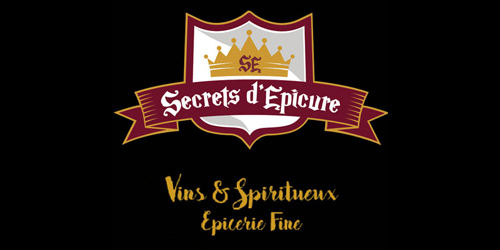
Wine and spirits store and delicatessen near Médipole hospital centre. Outlet for designs by Laser Art Pacific.
57, Boulevard Joseph Wamytan, Dumbéa, South Province
Open Tuesday to Thursday 9.30 a.m. to 7.30 p.m., Friday & Saturday 9.30 a.m. to 8 p.m. & Sunday 9.30 a.m. to midday
 46.11.20
46.11.20- This email address is being protected from spambots. You need JavaScript enabled to view it.

Work & designs by ARDICI artisans featured in this shop :
LASER ART PACIFIC
Retail outlet at Tit'Boutik & Co
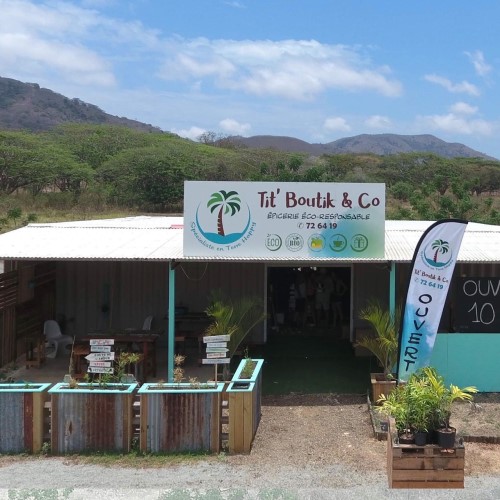
Eco-friendly grocery in La Foa stocking bulk foods, fruit and vegetables and a range of zero waste and organic products...
RT1 Fonimoulou, 98880 La Foa, South Province
Open Monday to Friday 9 a.m. to 5.30 p.m. & Saturday 8 a.m. to midday.
 72.64.19
72.64.19- This email address is being protected from spambots. You need JavaScript enabled to view it.

Work & designs by ARDICI artisans featured in this shop :
FOLIES D'SAVON
Retail outlet at Voyage Tropical
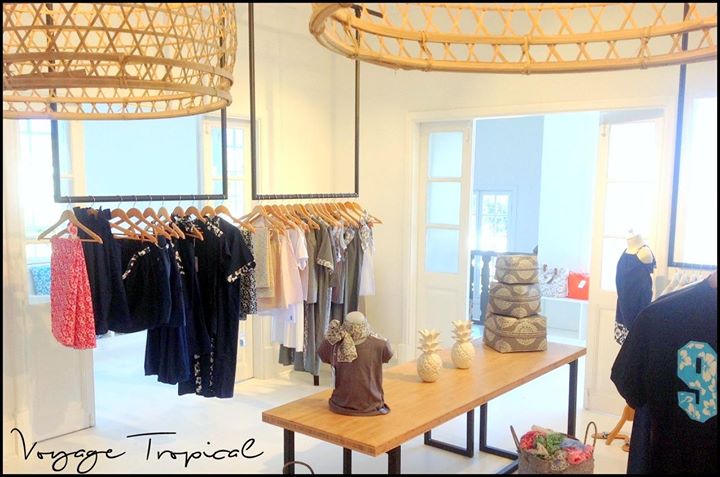
This store specialising in men’s, women’s and children’s fashion, household linen and accessories also carries South Pacific-inspired prints and posters by Ma Soeur Antoinette.
10, rue des frères Carcopino, Artillerie, Nouméa, South Province
Open Monday to Saturday 10 a.m. to 6 p.m.
 28.28.97
28.28.97- This email address is being protected from spambots. You need JavaScript enabled to view it.

Work & designs by ARDICI artisans featured in this shop :
MA SŒUR ANTOINETTE
Retail outlet at 123 Soleil
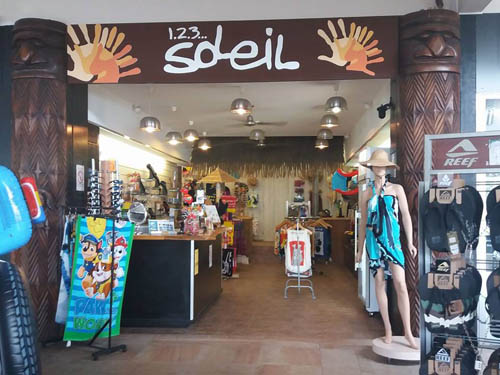
Store located at Baie des Citrons, specialising in souvenirs, beach apparel & accessories and also handcrafted designs. Outlet for products by Laser Art Pacific.
Mirage Plaza, Baie des Citrons, Nouméa, South Province
Open Monday to Saturday 10 a.m. to 6 p.m.
Work & designs by ARDICI artisans featured in this shop :
LASER ART PACIFIC
Lil O Bébé
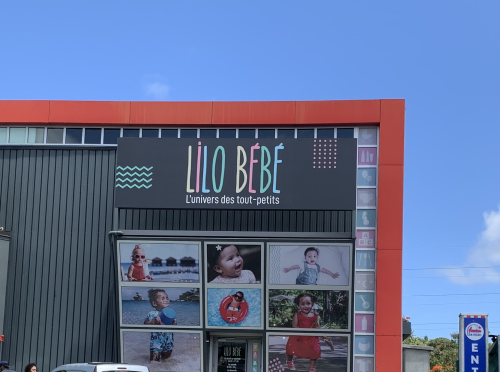
Shop specialising in items and accessories to delight all babies and toddlers.
1 Cœur de ville, promenade de Koutio, Noumea
Open Monday to Saturday 8.30 a.m. to 6.30 p.m. & Sunday 8.30 to midday
 24.04.74
24.04.74
- This email address is being protected from spambots. You need JavaScript enabled to view it.

Work & designs by ARDICI artisans featured in this shop :
La Poudre d’Escampi
Les Découvertes de Fabi
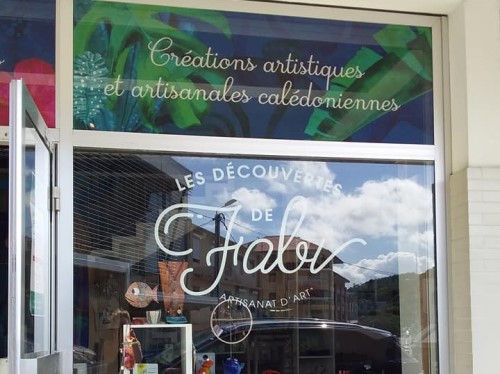
Les découvertes de Fabi is an arts and craft shop selling a range of original works by New Caledonian artists and designers (jewellery, pottery, paintings, unique ornaments...)
6 bis rue Bichat, Latin Quarter, Noumea, South Province
Open Monday afternoon from 2.30 p.m. to 5 p.m.
Tuesday to Friday from 9.30 a.m. to 5 p.m.
Saturday morning from 9 a.m. to midday
 81.58.68
81.58.68- This email address is being protected from spambots. You need JavaScript enabled to view it.

Work & designs by ARDICI artisans featured in this shop :
CRS NC
Gwenol'Art
Local Fairs and Festivals
Bourail Fait & Field days
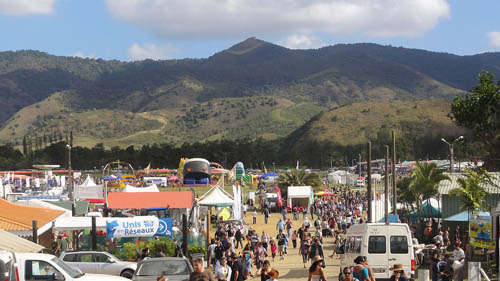
Bourail Fair and Field Days, New Caledonia’s biggest bush bonanza, is held every year over the mid-August weekend in the heart of the West Coast cowboy country. 3 days of fun and thrills for an authentic West Coast outback experience attracting over 15,000 visitors. A vast marquee is dedicated to local crafts, with over forty stalls displaying treasures from all three of New Caledonia’s provinces: sculptures, paintings, jewellery, fabrics, leather goods, essential oils and beauty care products... Over half the exhibitors are ARDICI members.
 46.46.12
46.46.12- This email address is being protected from spambots. You need JavaScript enabled to view it.


Pacifique Fair
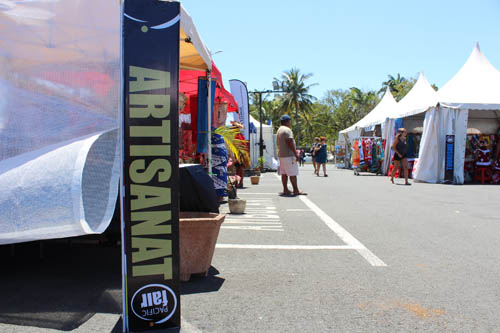
The Pacific Fair is a key local event featuring festivities, attractions, varied stalls and culinary specialities. It is held on around 10 October on the esplanade at Baie de la Moselle in Nouméa. Each year, a Pacific Region country is the special guest of honour. A grand gathering of over 200 exhibitors showcasing arts & crafts, tourism, gourmet food, deco... Fun, colourful and friendly !
 28.10.26
28.10.26- This email address is being protected from spambots. You need JavaScript enabled to view it.

Art Galleries
Andemic Art Gallery & Boutique
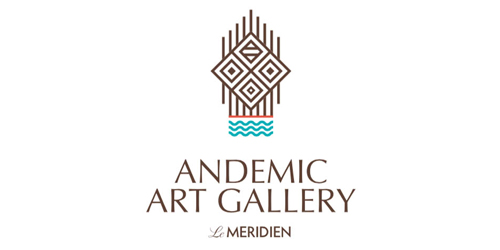
An unusual and exciting showcase for New Caledonia’s profusion of diverse talents. The gallery’s presiding genius is a brilliant talent spotter and works with artists and artisans from New Caledonia and around the world. You can rely on him for the very best help and advice in making your choice from his collection of unique and fascinating works. A relaxed, intimate gallery based in one of Nouméa’s most prestigious hotels.
« Le Méridien » Hotel
7, promenade Pierre VERNIER, Val Plaisance, Nouméa, South Province
Open Monday to Friday 9.30 a.m. to 12.30 p.m. & 2.30 to 7 p.m. Late opening Friday and Saturday until 8 p.m.
Sunday 3 to 7 p.m.
 74.77.44
74.77.44- This email address is being protected from spambots. You need JavaScript enabled to view it.

Work and designs by ARDICI artisans featured at this venue :
ACA.RY
ART ET PIERRES
ASA MARIA CHIPMAN
AUTOUR DE L'ARBRE
CALEBASSE D’ISA
CERAMIK'IM
IRIATAI
LASER ART PACIFIC
LES CENT CIELS DE JUNE
LES DESSINS DE MARION DIONNET
LES TOILES DES Z’ILES
MA SOEUR ANTOINETTE
MATHIEU TARDY
NÉ D’ARGILE
STUDIO DEL'ART
NOEMIE TIAOU
Galerie Arte Bello
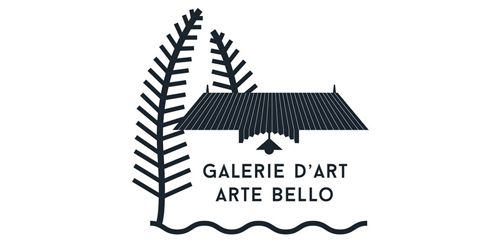
A favourite venue for New Caledonia's art lovers, Arte Bello gallery opened a new area dedicated to local arts & crafts in 2017. The gallery is set in the heart of the Latin Quarter and comprises various creative areas: exhibitions, a frame-making workshop, decorative objects and handcrafted designs. Feel free to ask for help and advice, the gallery staff adore talking about their treasures.
30, rue Auguste BRUN, Latin Quarter, Nouméa, South Province
Open Monday to Friday 9 a.m. to 6 p.m. & Saturday 9 a.m. to midday
 25.31.00
25.31.00- This email address is being protected from spambots. You need JavaScript enabled to view it.


Work and designs by ARDICI artisans featured at this venue :
CERAMIK'IM
CKOASA
ISABELLE STARON TUTUGORO
STUDIO DEL’ART
TRIBAL CUT
DZ Galerie
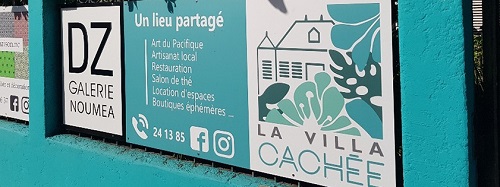
DZ Galerie specialises in the arts of Oceania (Aboriginal paintings and Oceanian artefacts). Dedicated to the concept that art is in constant flux and grows and is enriched by cultural exchanges, the gallery showcases all forms of artistic expression reflecting the vibrancy of Oceanian art and culture since the late 19th century.
Villa Cachée, 27 boulevard Extérieur – Faubourg Blanchot, Noumea
Open Monday to Saturday 9 a.m. to midday & 2 to 6 p.m.
 24.13.85
24.13.85- This email address is being protected from spambots. You need JavaScript enabled to view it.


Work and designs by ARDICI artisans featured at this venue :
MA SOEUR ANTOINETTE
Le Cargo des Arts
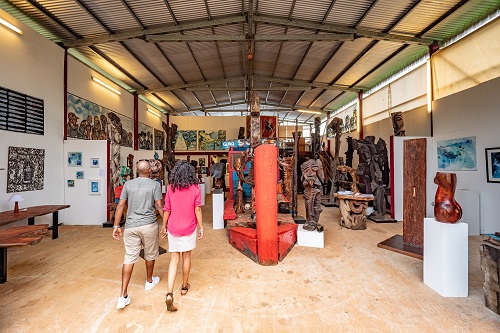
This studio/workshop in La Coulée serves as an exhibition space and also hosts art and design classes for young artists.
2458 bis, route de Mouirange
Route de Yaté – 98 876 La Coulée
 97.74.86
97.74.86- This email address is being protected from spambots. You need JavaScript enabled to view it.


Work & designs by ARDICI artisans featured in this shop :
LES DESSINS DE MARION
Galerie Lec Lec Tic
A stroll beside the lagoon at Anse Vata bay is the perfect opportunity to stop off at Lec Lec Tic gallery in La Promenade Complex: an art gallery overlooking the sea.
Complexe La Promenade, Nouméa, South Province
Open Tuesday to Saturday 2.30 p.m. to 6.30 p.m.
Work & designs by ARDICI artisans featured in this shop :
BIG ISLAND
LES DESSINS DE MARION
Hotels
Beaurivage Hotel Shop

Reopened in 2013 after a major makeover and boasting an ideal location overlooking Baie des Citrons beach, Beaurivage Hotel stocks apparel designed by Ma Sœur Antoinette.
7, Promenade Roger Laroque, Nouméa, South Province
 26.20.55
26.20.55- This email address is being protected from spambots. You need JavaScript enabled to view it.

Work & designs by ARDICI artisans featured in this shop :
MA SŒUR ANTOINETTE
Le Lagon Hotel Shop
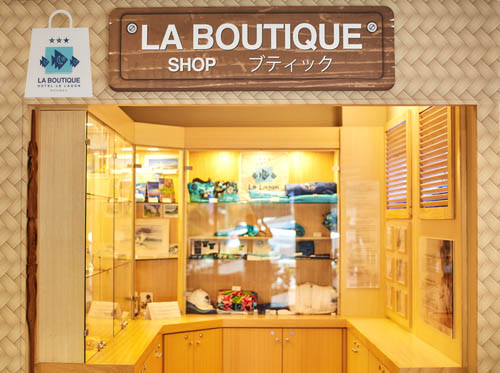
Le Lagon hotel is ideally located in Nouméa’s key tourist area, just 100 metres from beaches, restaurants and shops. The hotel’s shop gives pride of place to locally handcrafted items.
149, route de l'Anse Vata, Nouméa, South Province
 26.12.55
26.12.55- This email address is being protected from spambots. You need JavaScript enabled to view it.


Work & designs by ARDICI artisans featured in this shop :
HUE COCOTTE
ISABELLE STARON TUTUGORO
LES CENT CIELS DE JUNE
MA SŒUR ANTOINETTE
Sheraton Hotel Shop
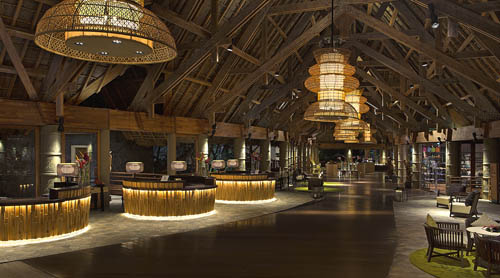
Luxury 5-star Sheraton New Caledonia Deva Spa & Golf Resort offers local and international guests a selection of original artworks and craft designs displayed in its exclusive boutique.
DEVA Domain, Route de Poé, Bourail, South Province
 26.70.00
26.70.00- This email address is being protected from spambots. You need JavaScript enabled to view it.


Work & designs by ARDICI artisans featured in this shop :
CREATION PUNAA MAEVA
LES TOILES DES Z’ILES
LES CENT CIELS DE JUNE
Cooperative or collective outlets
Arti'Fées
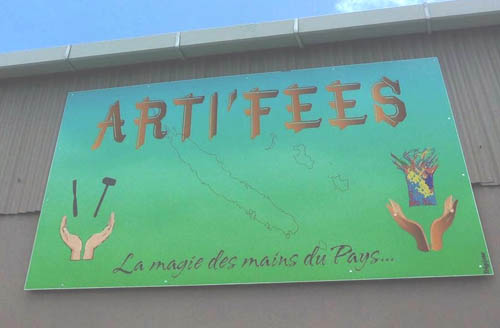
Collaboration and cultural discovery are central to this shared retail space, which stocks a selection of designs and items from all over New Caledonia. FÉES Association plays an active role in creating a go-ahead network of designers who show and sell their creations in this downtown Nouméa venue. Look out especially for items fashioned with traditional skill by women from the North and the Islands.
Quai Jules FERRY, Nouméa, South Province
Open Monday to Friday 8 a.m. to 5 p.m.
 91.64.21
91.64.21- This email address is being protected from spambots. You need JavaScript enabled to view it.

Work & designs by ARDICI artisans featured in this shop :
AU VIEUX GRIMOIRE
BRODART
BAKWA NOU
CKOASA
COUTURE BRIGITTE
GWENOL'ART
IRIATAI
KIRIGAMI
LES PETITS PLUS DE LEKA
NOÉMIE TIAOU
THÉ BAÏDE
TOFA UVEA
Atelier des Femmes
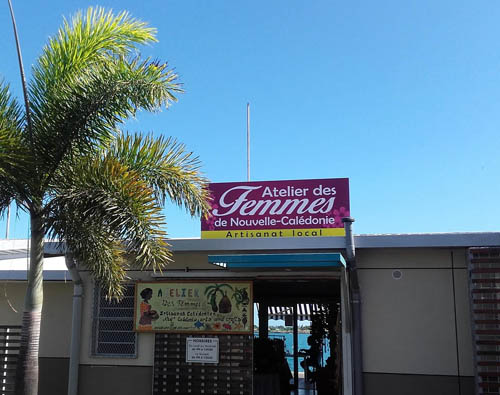
Store run by the New Caledonia Women’s Association with the aim of promoting local handicrafts. The store stocks work by women artisans from all New Caledonia’s provinces: woven work, braiding, fabrics and clothing, paintings, jewellery, sculptures... These talented women also drop by with their latest creations. The perfect place for great gift ideas.
Ferry Market Complex, Quai Ferry, Nouméa, South Province
Open Monday to Friday 9 a.m. to 4 p.m. & Saturday 9 a.m. to midday
Work & designs by ARDICI artisans featured in this shop :
CAMICOO
C'Ô SOLEIL
CREATIONS PARIS NOUMEA
LE STAND D’IRENE
LES CENT CIELS DE JUNE
TONY C
Coccoloba
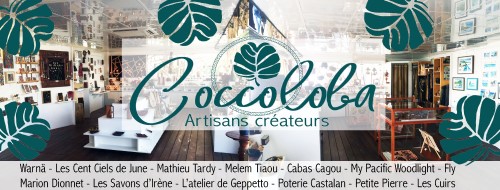
Store selling work by a collective of New Caledonian arts and crafts artists and designers.
33, promenade Roger Laroque, Nouméa, Complexe Commercial Baie, Province Sud
Open Tuesday to Saturday 10.30 a.m. to 6 p.m. & Sunday 11 a.m. to 6 p.m.
 52.61.98
52.61.98- This email address is being protected from spambots. You need JavaScript enabled to view it.

Work & designs by ARDICI artisans featured in this shop :
LA POUDRE D'ESCAMPI
LES CENT CIELS DE JUNE
LES DESSINS DE MARION (DIONNET)
LE STAND D'IRENE
MATHIEU TARDY
MELEM TIAOU
MAROQUINERIE CABAS CAGOU NC
MY PACIFIC WOOD LIGHT
LES CUIRS
POTERIE CASTALAN
PETITE PIERRE
WARNA
La Boutique Partagée
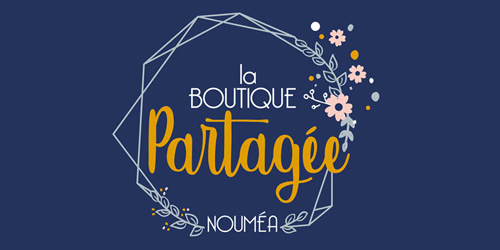
Ethics and sustainability are key issues for La Boutique Partagée, nestled in a shady green setting in the heart of Nouméa. The store stocks handcrafted items from near and far, featuring a delightful and constantly updated range of diverse products: fashion and fabrics, ornaments, jewellery, stationary, organic beauty care and even tasty treats. A dozen ARDICI members show their designs here.
79, route de l’Anse Vata, Nouméa, South Province
Open Tuesday to Saturday 9 a.m. to 6 p.m.
Work & designs by ARDICI artisans featured in this shop :
CABAS CAGOU
FOLIE D'SAVON
LES CALEBASSES D’ISA
CAMICOO
HUE COCOTTE !
LA PATTE DE PIM'S
LA SALINE
LES CENT CIELS DE JUNE
MA SŒUR ANTOINETTE
MOON FLOWER
NIRINA CREA
PETITE PIERRE
WARNA
La Coop à Nous
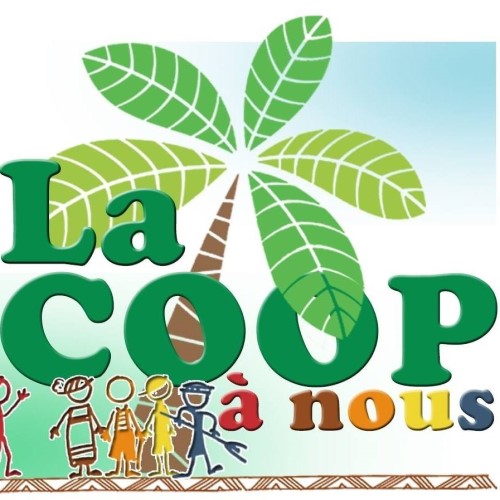
La Coop à Nous is a cooperative and participatory grocery store focussing on the sale of healthy GMO-free products.
14 rue bouquet de la Grye, Vallée des Colons, South Province
 70.58.06
70.58.06- This email address is being protected from spambots. You need JavaScript enabled to view it.


Work & designs by ARDICI artisans featured in this shop :
BAEBAO
Maison des Artisans Craft centre
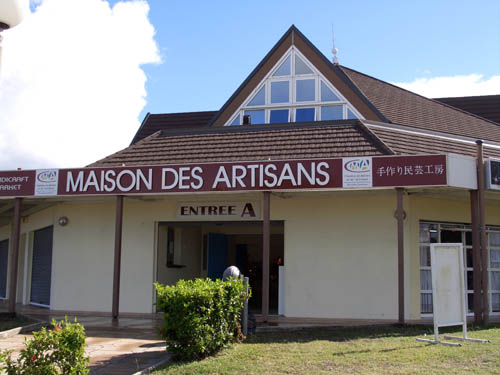
The perfect place to see creative crafts in action: fabrics and sarongs, jewellery and South Pacific pearls, ceramics and pots, painting on glass and porcelain, traditional sculptures in wood and soapstone... all taking place before your eyes! The studio/shops housed in Maison des Artisans craft centre are heaven for all visitors eager to see local artisans at work. And, of course, you are very welcome to buy the items you’ve watched being made! 100% made in New Caledonia !
12, avenue James Cook, Nouville, Nouméa, South Province
Open Monday to Friday 8.30 to 11.30 a.m. & 2.30 to 5 p.m., Saturday 8.30 to 11.30 a.m.
 27.56.85 et 77.30.90
27.56.85 et 77.30.90- This email address is being protected from spambots. You need JavaScript enabled to view it.


Work and designs by ARDICI artisans featured at this venue :
CRÉARGILE
C'Ô SOLEIL
DOM ENCADREMENT
DOMINA CADRE
HUE COCOTTE !
La villa cachée
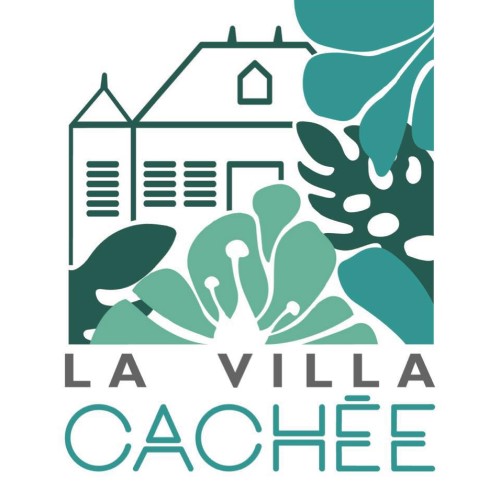
A charming colonial villa provides a relaxed, friendly setting for an art gallery, the “Créateurs NC” art concept store, massage & therapy specialists, a financial & asset management consultant, a delightful garden used for cultural events and an eco-friendly restaurant and café.
Villa Cachée, 27 boulevard Extérieur – Faubourg Blanchot, Noumea
 24.13.85
24.13.85- This email address is being protected from spambots. You need JavaScript enabled to view it.

Work & designs by ARDICI artisans featured in this shop :
BB SCULPTURE
Les arts du pacifique
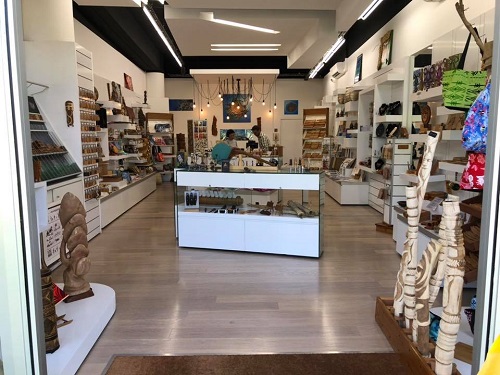
In early 2019, a new store specialising in locally crafted New Caledonian handicrafts opened in Anse Vata. Far from just a souvenir shop, the new store is a space showcasing local artists and craftspeople and their creations: sculptures & carvings, pens, sarongs, watercolours, soaps, vanilla... and a wealth of other treasures.
La Promenade Complex, Anse vata
Open 7/7 from 9 a.m. to 7 p.m.
Work & designs by ARDICI artisans featured in this shop :
ALM ASA MARIA EPOUSE CHIPMAN
BIJOUTERIE ACA.RY
BLEU CITRON / ISABELLE STARON TUTUGORO
CAMICOO
C'O SOLEIL
CREATIONS PARIS NOUMEA
CRS.NC
HEITAMA FABRICATION
HELEPSHOP
HUE COCOTTE
ISSAMATRO
LA RUCHE NATURE B. CASTALAN
LASER ART PACIFIC
L'ATELIER DE VAL
LE STAND D'IRENE
LES TOILES DES Z'ILES
MA SŒUR ANTOINETTE
MATHIEU TARDY
MY PACIFIC WOOD LIGHT
NE D'ARGILE
NIRINA CREA
SOCIETE NATURAMI
STUDIO DEL'ART (DELPHINE TANTI)
TIAOU MELEM
TIAOU NOEMIE
TONY C
UNIQUE ET NATUREL
WAIMANA
WARNA
Key tourist attractions
Nouméa Lagoon Aquarium Shop
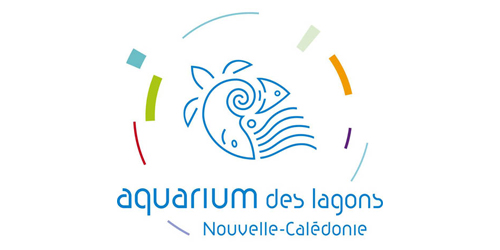
Nouméa’s Lagoon Aquarium, a top attraction for New Caledonian families and visitors keen to learn more about our lagoon, boasts a shop full of life and colour which also features marine-themed artwork by local artisans.
61, promenade Roger Laroque, Anse Vata, Nouméa, South Province
Shop open Tuesday to Sunday 10 a.m. to 5 p.m.
 26.27.31
26.27.31- This email address is being protected from spambots. You need JavaScript enabled to view it. This email address is being protected from spambots. You need JavaScript enabled to view it.


Work & designs by ARDICI artisans featured in this shop :
C'Ô SOLEIL
STUDIO DEL'ART
Tjibaou Cultural Centre Shop
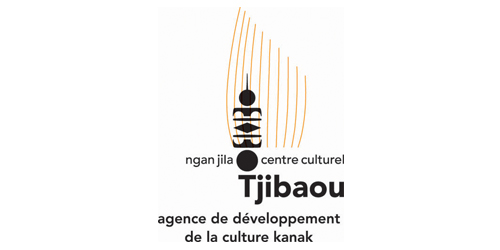
The Tjibaou Cultural Centre, designed by world-renowned architect Renzo Piano, is an iconic masterpiece offering an in-depth experience of Kanak culture. Don’t miss the centre’s amazing permanent and temporary exhibitions and mystic gardens evoking local legends. The shop is filled with fascinating artefacts showcasing New Caledonia’s ancient cultural heritage and vibrant contemporary creative talents. You’ll find finely handcrafted items perfect for an unusual gift or souvenir of your stay. The shop also stocks books, journals, posters, postcards and more. Plunge into the world of Oceanian and local traditions...
Rue des accords de Matignon, Tina Golf, Nouméa, South Province
Shop open Tuesday to Saturday 9 a.m. to 1 p.m. & 1.45 to 5 p.m., Sunday 10 a.m. to 1 p.m. & 1.45 to 5 p.m.
 41.45.45
41.45.45- This email address is being protected from spambots. You need JavaScript enabled to view it.


Work & designs by ARDICI artisans featured in this shop :
ASA MARIA CHIPMAN
ISABELLE STARON TUTUGORO
KOGHIS PEINTURE
LES CENT CIELS DE JUNE
MA SŒUR ANTOINETTE
MOON FLOWER
NATURAMI
SEA ART
Musée maritime Shop
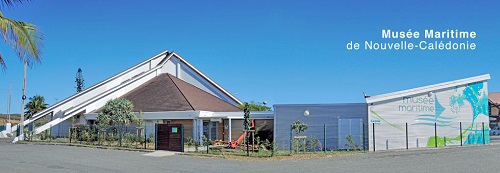
The Musée Maritime de Nouvelle-Calédonie is located on the road to Nouville, within walking distance from the town centre. It was open in 1999, in the premises of the former maritime terminal, which were made available by the Noumea Port Authority.
11 avenue James Cook à Nouville – Nouméa
Open Tuesday to Sunday 9 a.m. to 5 p.m. – Closed every Monday
 26.34.43 ou 28.68.21
26.34.43 ou 28.68.21
- This email address is being protected from spambots. You need JavaScript enabled to view it. This email address is being protected from spambots. You need JavaScript enabled to view it.

Work & designs by ARDICI artisans featured in this shop :
ASA MARIA CHIPMAN
Bourail Tourism Office Shop
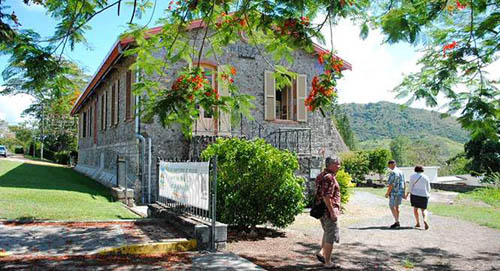
A small shop on the ground floor of the Bourail Museum, offering a selection of local crafts.
Rue Simone Dremon, Bourail, South Province
Open Monday to Saturday 9 a.m. to midday & 1 to 5 p.m.
 Catherine DAVERAT : 46.46.12 et 75.68.68
Catherine DAVERAT : 46.46.12 et 75.68.68- This email address is being protected from spambots. You need JavaScript enabled to view it.

Work & designs by ARDICI artisans featured in this shop :
LES TOILES DES Z’ILES
MA SOEUR ANTOINETTE
Deep South Tourism Office shop
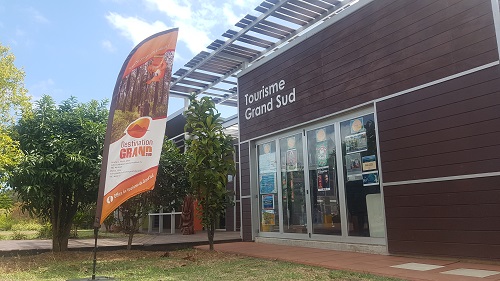
Located in Boulari, this tourist office provides visitors with a wealth of information about must-see events and activities scheduled in New Caledonia’s Deep South (Mont-Dore and Yaté).
The shop also features a range of local craft products to buy and take home.
Rond-point des Sports de Boulari, Mont-Dore, South Province
Work & designs by ARDICI artisans featured in this shop :
ASA MARIA CHIPMAN
C3D
ESSENCE DE GRAINES
KOGHI PEINTURE
LASER ART PACIFIC
LE STAND D'IRENE
La Foa Tourism Office Shop
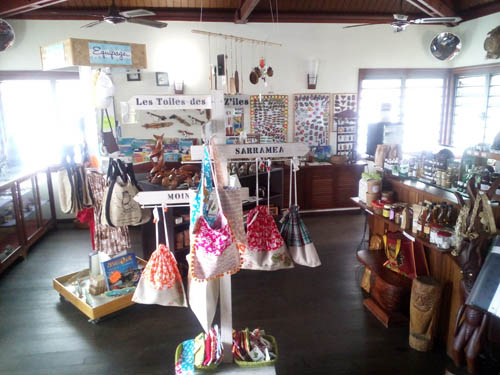
La Foa Tourism Office shop is crammed with intriguing finds and craft items from all over New Caledonia including, of course, La Foa and the surrounding region. The enthusiastic team takes great care to stock the shop with tempting items and is always on the lookout for new products.
RT1, place publique Georges Guillermet, La Foa, South Province
Open Monday to Saturday 8.30 a.m. to 4.30 p.m. & Sunday 8.30 to 10.30 a.m. Closed every 1st Wednesday in the month
 41.69.11
41.69.11- This email address is being protected from spambots. You need JavaScript enabled to view it.


Work & designs by ARDICI artisans featured in this shop :
DOM ENCADREMENT
ISABELLE STARON TUTUGORO
FOLIE D'SAVON
KOGHIS PEINTURE
LES CENTS CIELS DE JUNE
LES TOILES DES Z’ILES
MA SŒUR ANTOINETTE
MATHIEU TARDY
NATURAMI
TOUT EN CANETTES
Noumea Tourism Office Shop

The Noumea Tourism Office is tasked with promoting Noumea and New Caledonia as a tourist destination; recently the Tourism Office opened a shop, located on the Quais Ferry in central Noumea and stocking a wide range of authentic and exclusive handcrafted items by ARDICI label local artisans.
22 quai Jules Ferry, Gare Maritime
Open Monday to Friday 8 a.m. to 5 p.m. & Saturday 9 a.m. to 3.30 p.m. & Sunday 9 a.m. to 4 p.m.
 05.75.80
05.75.80- This email address is being protected from spambots. You need JavaScript enabled to view it.

Work and designs by ARDICI artisans featured at this venue :
BLEU CITRON
DANS MA BULLE
KOGHIS PEINTURE
STUDIO DEL’ART
VIP
Markets
Alternative Market
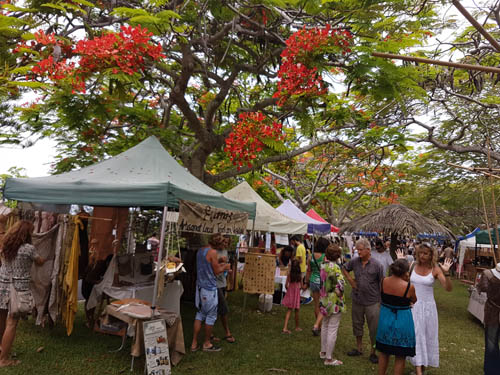
A cooperative market which promotes sustainability initiatives by bringing together nature lovers, health and organic products enthusiasts and makers of handcrafted, environmentally friendly products (upcycling...). The market is held two or three times a year.
Botanical & Wildlife Park, Nouméa, South Province
Open 10 a.m. to 8 p.m. (specific dates)
 80.60.96
80.60.96- This email address is being protected from spambots. You need JavaScript enabled to view it.


Work and designs by ARDICI artisans featured at this venue :
CABA CAGOU
LES CALEBASSES D’ISA
CKOASA
HUE COCOTTE!
LADY BEE COSMETIQUES
LES TOILES DES Z’ILES
PETITE PIERRE
POTERIE CASTALAN
PUKEKO
RESSAC
Ballande Market
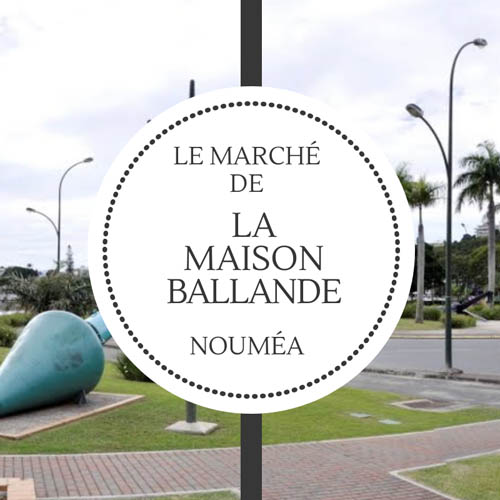
Every Saturday, there is a small market on the carpark in front of Maison Ballande wine store & delicatessen opposite Baie de l’Orphelinat, with stalls selling fresh local produce and arts and crafts.
1, rue Jules GARNIER, Baie de l’Orphelinat, Nouméa, South Province
Open Saturday 9 a.m. to midday
 28.20.33
28.20.33- This email address is being protected from spambots. You need JavaScript enabled to view it.

Work and designs by ARDICI artisans featured at this venue :
ACA.RY
LES TOILES DES Z’ILES
UNIQUE ET NATUREL COSMETIQUES
Bush Market
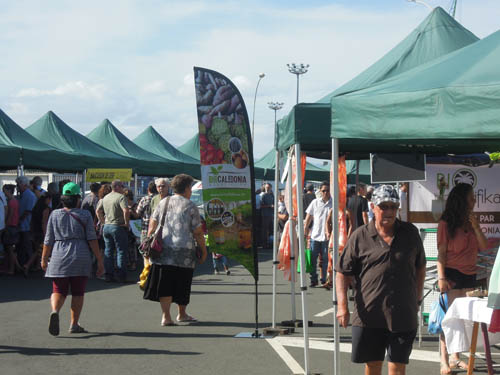
The Bush Market is all about direct-to-consumer sales and provides a regular venue in various locations for market gardeners, makers of home-made produce and craftspeople.
Le Marché Broussard Association (bush market)
3, rue Alcide Desmazures, Nouméa, South Province
Every Saturday from 5 a.m. to midday in DUCOS market hall (occasional alternative venues: check out their schedule)
 72.71.71
72.71.71- This email address is being protected from spambots. You need JavaScript enabled to view it.


Work and designs by ARDICI artisans featured at this venue :
PUKEKO
POTERIE CASTALAN
SEA ART
Farino Market
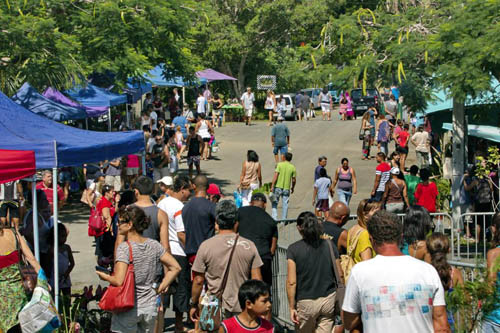
Farino market is held once a month on a superb site commanding panoramic views over the valley. The market is a relaxed, family-friendly event, often with a special theme, and the stalls overflow with fresh home-grown produce and locally handcrafted items.
New Townhall esplanade
Place Paul Louis MARIOTTI, Farino, South Province
2nd Sunday in the month, open from 8 a.m. to midday
Work and designs by ARDICI artisans featured at this venue :
LES TOILES DES Z’ILES
PARER AU SOLEIL
Downtown Thursday Market
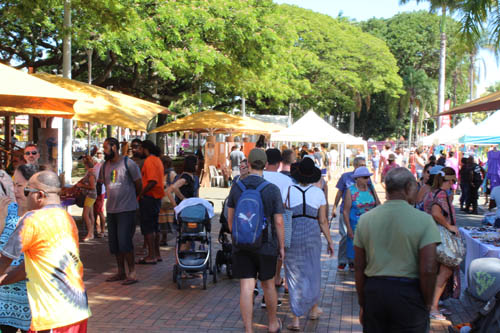
Themed events organised regularly by Nouméa Centre Ville association and featuring a wide range of products, various attractions and a lively atmosphere. ARDICI artisans often take part in events.
Nouméa Centre Ville Association
15 rue de Verdun, Downtown, Nouméa, South Province
 28.02.07
28.02.07- This email address is being protected from spambots. You need JavaScript enabled to view it.

Pacific Market
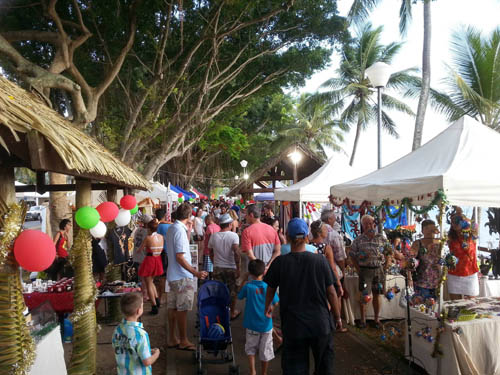
Themed markets held every month under the wooden farés bordering Anse Vata beach. Live music and attractions ensure an exotic South Pacific ambiance. Browse stalls selling handicrafts, jewellery, apparel, sarongs, pictures, hats, pickles, preserves, Thai specialities and much more...
Under the Anse Vata Farés
Every 2nd Wednesday in each month, from 11 a.m. to 7 p.m.
 81.28.31
81.28.31- This email address is being protected from spambots. You need JavaScript enabled to view it.

Work and designs by ARDICI artisans featured at this venue :
BAKWA NOU
CREALIE BIJOUX DE CORPS
LE STAND D'IRENE
LES CALEBASSES D’ISA
RM CREATIONS
SEA ART
MISSAMMÉ
Nouméa City Market
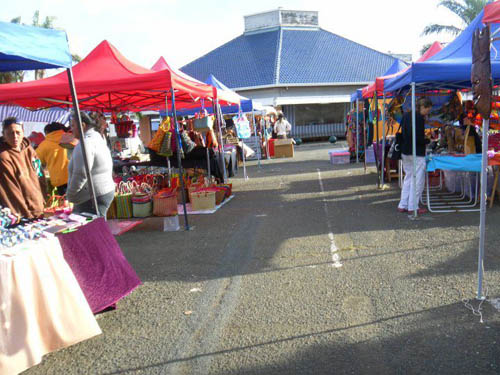
The city market beside Baie de la Moselle marina is a favourite meeting place for locals and visitors and a showcase for the finest local produce. Artisans and traders fill the indoor area with its vibrant central café, while fifteen craftspeople preside over outdoor stalls selling authentically New Caledonian souvenir items.
Baie de la Moselle
50 bis, rue Georges CLEMENCEAU, Nouméa, South Province
Open Tuesday to Sunday 5 to 11.30 a.m.
Work and designs by ARDICI artisans featured at this venue :
CERAMIK'IM
C'Ô SOLEIL
CREALIE BIJOUX DE CORPS
CREASTYLE
CRS NC
FLAME
HUE COCOTTE !
ILOHA CREATIONS
INSPIRATION NATURE NC
L'ATELIER DE VAL
LES CUIRS
LES SAVONS DE NOUVELLE-CALEDONIE
LE STAND D’IRENE
LES CENT CIELS DE JUNE
MARION LA BARRE
MEAUME ALEXANDRE
PARER AU SOLEIL
PINKAEW
KHANJAY
POTERIE CASTALAN
PUKEKO
RACHOUETTE
SEA ART
S'PRIDICI
STUDIO DEL ART
TAKU POE
TOUT EN CANETTES
WARNA
Trade Shows
Trade shows provide the perfect opportunity to check out new local talent. Shows are held throughout the year and attract a wide range of local artists and craftspeople.
Mother’s Day Craft Fair
In May, organised by the New Caledonian Crafts Association at Maison des Artisans
Health & Wellness Show
In June
 91.60.57
91.60.57- This email address is being protected from spambots. You need JavaScript enabled to view it.

Nature & Garden Show
In early September, organised by Dumbea town authorities
 77.22.27
77.22.27- This email address is being protected from spambots. You need JavaScript enabled to view it.

Online Sales
CKOASA.COM
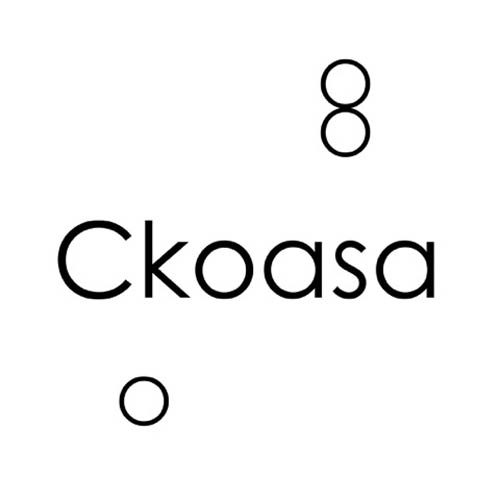
Catherine THOMAS, creator of the unique CKOASA jewellery range, has designed her online store to reflect the simple elegance of her jewellery. Keenly aware of environmental concerns, she creates necklaces, bracelets and earrings using recycled materials, transformed into striking on-trend personal statement pieces. English-language option with prices in Australian dollars.
Colis Calin

ColisCalin® is a 100% authentic New Caledonian gift box filled with local produce and specialities which you can order to be shipped to friends or family in France, Australia, Japan and New Zealand. Items include handicrafts sourced from around the country.
Work & designs by ARDICI artisans featured in this online store :
LES TOILES DES Z’ILES
STUDIO DEL'ART
La Boutique Zéro Déchet
Website designed to provide a single online platform for home and household products, groceries and leisure and wellbeing accessories, making it easy to buy all sorts of sustainable and reusable items with just one click.Le Village, 35 Avenue FOCH, centre ville, Nouméa, Province Sud
Work & designs by ARDICI artisans featured in this e-shop :
BAEBAO
DISTILLERIE DE BOULOUPARIS
MAMOU SAVONS
UNIQUE ET NATUREL
Shop.nc

New Caledonia’s online store which carries the widest range of products and features an “art and culture” category, with a subcategory specifically for local artisans.
Work & designs by ARDICI artisans featured in this e-shop :
AFRIKADES
CUIR O NATUREL
DOMINA CADRE
FOLIE D'SAVON
IRIATAI
KIM ET STELLA DESIGN
MISSAMME
NATURAMI
NE D’ARGILE
RACHOUETTE
RESSAC
RM CREATIONS
SAVONEA
Pop-up Sales Outlets
Some artisans only show their designs at pop-up sales outlets so it’s worth keeping an eye on the schedule of events. Go to the Chamber of Trades and Crafts Facebook page for details on dates and venues for these pop-up sales, and check the Facebook pages of your favourite ARDICI artisans.
North Province
Ardici artisan workshops open to the public
C2B Artisan Bijoutier
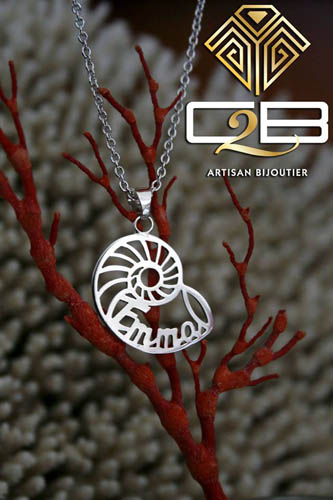
Cécile BONIS loves giving free rein to her imagination as she works in her studio on the creation of solid gold or silver jewellery embellished with precious stones such as rubies and star sapphires. She also creates made-to-order designs and carries out repair and restoration work, including watches.
101 rue des Filaos, Koné, North Province
Open Monday to Friday 10 a.m. to midday & 2 to 5.30 p.m., Saturday 9 a.m. to midday
Chez Brigitte
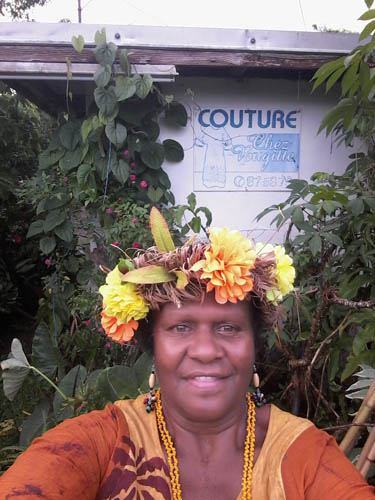
Brigitte GOWEMEUHOU has worked as a seamstress for more than 30 years. In her workshop, she creates designs with brightly coloured fabrics to delight her customers. Her tunics and dresses are often decorated with seed and shell embellishments. Brigitte takes an active part in Women’s Days and Melanesian festivals, demonstrating the skills and know-how of traditional seamstresses.
NESSA KOAUYA Tribe, Houaïlou, North Province
L'Art de Fer

Swan Yegikyan crafts artworks in iron. He works with all kinds of iron and creates indoor & outdoor furniture, window railings, guardrails, gates and portals, and decorative designs. He is happy to create customised pieces to order.
Z.I. Les CASSIS (behind Seigneurie), 535 rue des Cassis, Koné, North Province
 96.04.69
96.04.69- This email address is being protected from spambots. You need JavaScript enabled to view it.

Lolo Boutic
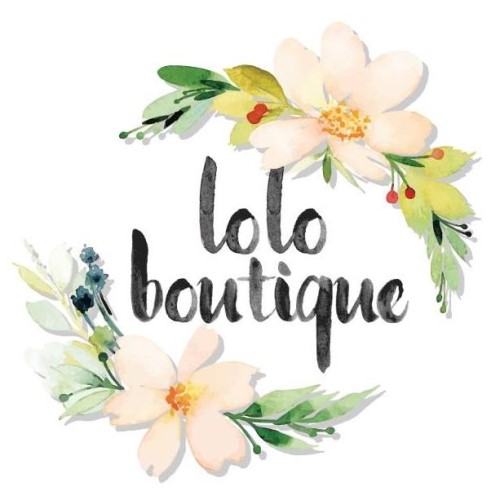
Laurence TARPINIAN is based in Koné, where she designs and makes princess dresses, fancy dress outfits, communion or confirmation dresses for young girls and wedding and evening dresses for women.
42 Lotissement Cassis 98850, Koné, Province Nord
 71.28.89
71.28.89- This email address is being protected from spambots. You need JavaScript enabled to view it.

Stores providing Retail outlets
Retail outlet at O Bocal VKP
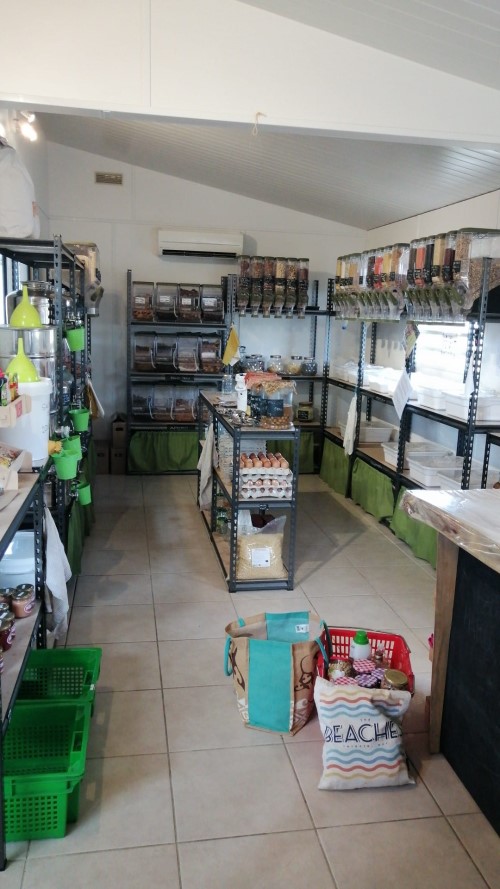
Eco-friendly bulk grocery store selling food products containing over 80% organic ingredients, local natural beauty products and local craft items for kids and adults alike.
Rue des cassis, koné, Province Nord
Open Tuesday to Friday 9 a.m. to 1 p.m. and 2 p.m to 5 p.m. & Saturday 9 a.m. to midday.
 85.53.84
85.53.84- This email address is being protected from spambots. You need JavaScript enabled to view it.

Work and designs by ARDICI artisans featured at this venue :
LA PATTE DE PIM'S
MAMOU SAVON
Kouaoua Mobil Service Station

Rural service station where you can buy dresses made by Brigitte Gowemeuhou.
Kouaoua Village, North Province
Work and designs by ARDICI artisans featured at this venue :
CHEZ BRIGITTE
Local Fairs and Festivals
Koumac Fair and Field days
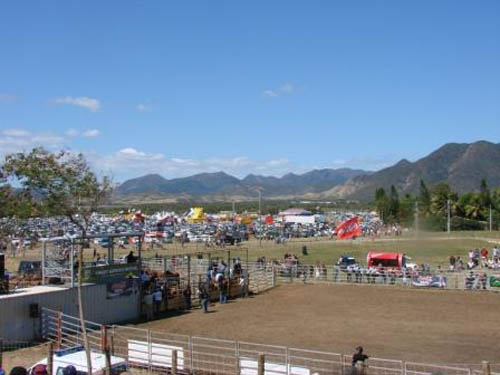
Koumac Fair, held every year around 24 September, is a big traditional bush get-together attracting flocks of visitors eager for an authentic New Caledonian outback experience. Join the local cowboys for a weekend of equestrian games, horseraces and a rodeo, fun attractions, contests and stalls selling fresh produce and arts & crafts.
 42.78.42
42.78.42- This email address is being protected from spambots. You need JavaScript enabled to view it.

Hotels
Le Karem Bay Hotel Shop
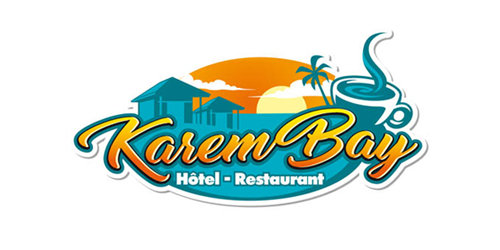
Boasting an ideal location on the heights above Karembé Bay just south of Koumac, this B&B hotel stocks local sculptures in wood.
Lot 447 RPN1, Karembé, Koumac, North Province
Open weekdays from 6 a.m. to 8 p.m.
 46.77.70
46.77.70- This email address is being protected from spambots. You need JavaScript enabled to view it. This email address is being protected from spambots. You need JavaScript enabled to view it.


Work & designs by ARDICI artisans featured in this shop :
LASER ART PACIFIC
Tiéti Hotel in Poindimié

Tiéti Hotel, on the outskirts of Poindimié, sits right next to one of the loveliest beaches in the North Province. The hotel boasts a show area given over to local arts and crafts and Poindimié-based artist Isabelle TUTUGORO regularly exhibits her work there. Tiéti Hotel acts as president and showcase for ART'EAST Association, supported by the Chamber of Trades and Crafts, which brings together East Coast artists and artisans.
16 Voie Urbaine 1, Poindimié, North Province
 42.64.00
42.64.00- This email address is being protected from spambots. You need JavaScript enabled to view it.


Work & designs by ARDICI artisans featured in this shop :
ISABELLE STARON TUTUGORO
LES PETITS PLUS DE LEKA
MAMOU SAVONS
Markets
Canal Market
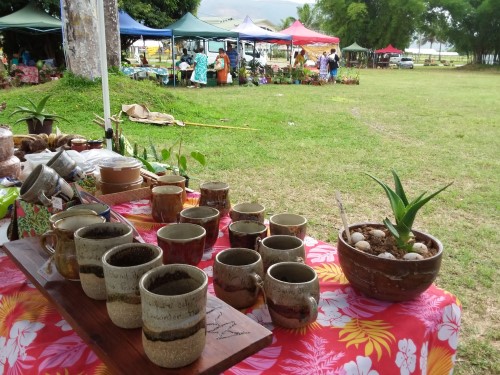
Canala municipal market.
1, rue Marcel Nonnaro, Canala, North Province
Open friday 8 a.m to midday
Work and designs by ARDICI artisans featured at this venue :
HOTE DE CES TERRES
Téari Northern Market
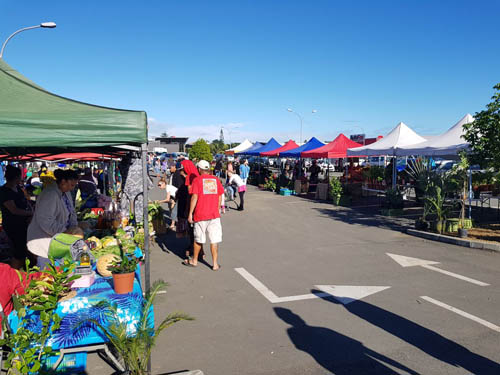
The big North Province market, a magnet for local communities, is held regularly on TEARI shopping centre carpark. North Province producers and craftspeople, joined by others from the South Province, flock there to show off their skills and products.
TEARI Shopping centre
254, lotissement Green Acre, Koné, North Province
Open once a month from 8 a.m. to 2 p.m.
 47.58.75
47.58.75- This email address is being protected from spambots. You need JavaScript enabled to view it.

Work and designs by ARDICI artisans featured at this venue :
PETITE PIERRE
COULEURS D’OUTRE MER
Loyalty Islands Province
Ardici artisan workshops open to the public
Dricke ISSAMATRO
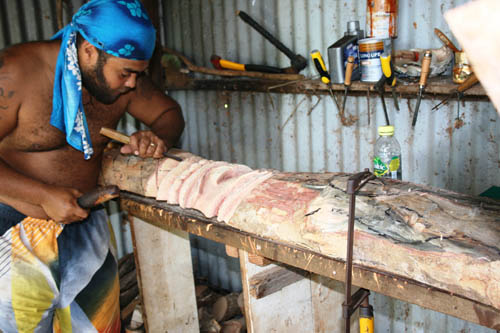
Dricke is a master sculptor in wood, carving rooftop totems, traditional Kanak huts and ritual totems in every size. He also creates work to order.
HNATALO Tribe, Lifou, Loyalty Islands Province
Edmond HACE
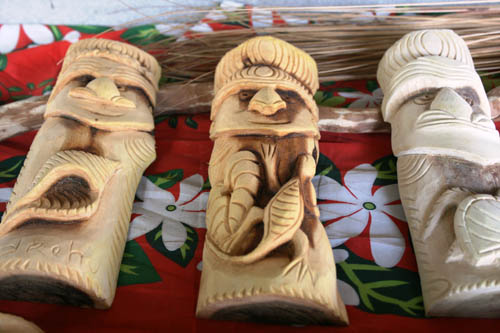
In his seafront studio open to the public, Edmond fashions the finest and most noble woods found on his island into works of art fusing tradition with innovation.
JOZIP Tribe, Lifou, Loyalty Islands Province
Oriatal Couture
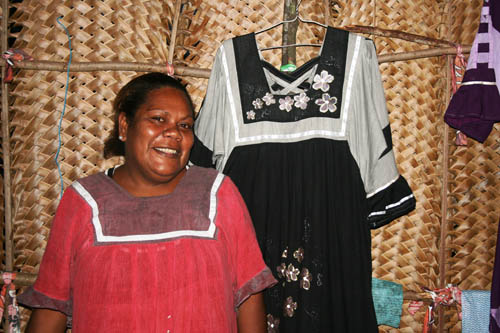
Expert seamstress Marie-Rose Thihmhna welcomes visitors by appointment. She designs traditional garments, dyed and painted by hand: Mother Hubbard dresses, tops, tunics and also sets for children. Look out for the orange markets on the fence.
XODRE Tribe, Lifou, Loyalty Islands Province
Tribal Cut
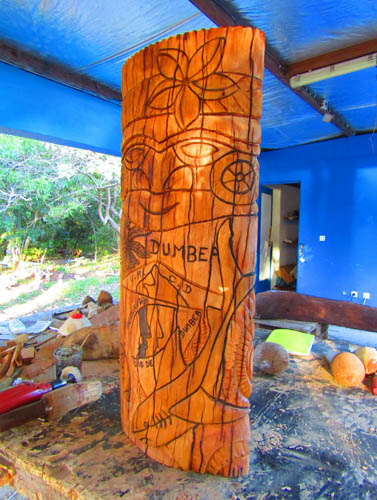
When you’re in Ouvéa, look out for the “Sculptor” sign on the main road and visit Marjorie Tiaou in her studio. She will welcome you to her traditional faré and show you her designs fusing tradition with innovation: flick knives and machetes with carved handles, Kanak doorposts, rooftop totems and huts. Marjorie is also happy to ship her designs to destinations throughout New Caledonia and the rest of the world.
LEKINE Tribe, Ouvéa, Loyalty Islands Province
Local Fairs and Festivals
Loyalty Islands Fair
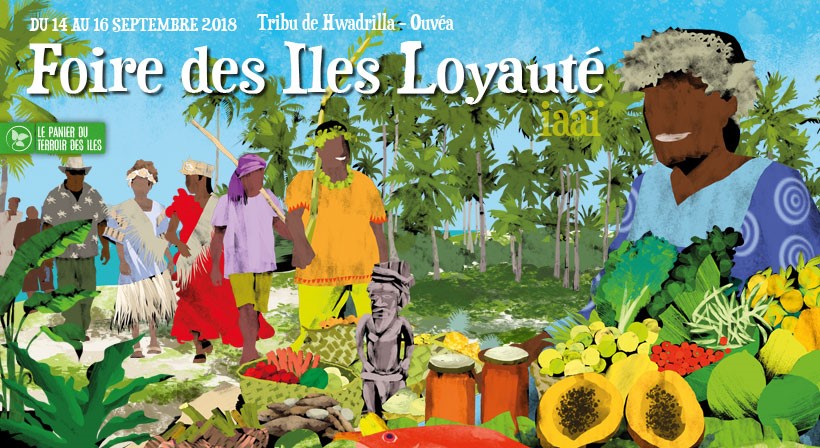
Around mid-September
Major agricultural, cultural and craft fair held every year on one of the three Loyalty Islands (Maré, Lifou or Ouvéa).
 24.22.63
24.22.63- This email address is being protected from spambots. You need JavaScript enabled to view it.
Hotels
Oasis de Kiamu Hotel
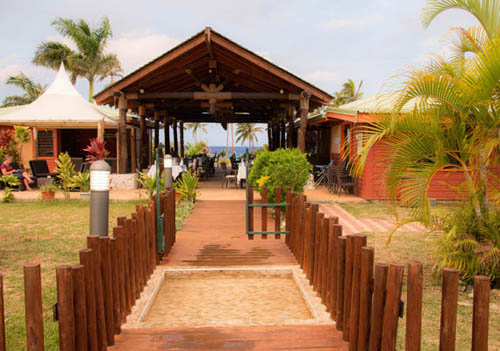
The hotel is nestled in the heart of the Hnaeu Tribe land, a stone's throw from the beach and at the foot of a cliff. A souvenir and gift area in the hotel lobby offers locally handcrafted items as well as imported products. You can also find designs by some artisans native to Lifou.
RM1, Jozip, Lifou, Loyalty Islands Province
 45.15.00
45.15.00- This email address is being protected from spambots. You need JavaScript enabled to view it. et This email address is being protected from spambots. You need JavaScript enabled to view it. This email address is being protected from spambots. You need JavaScript enabled to view it.


Work and designs by ARDICI artisans featured at this venue :
BOUG’ILES
DRICKE ISSAMATRO
EDMOND HACE
Paradis d'Ouvéa Hotel
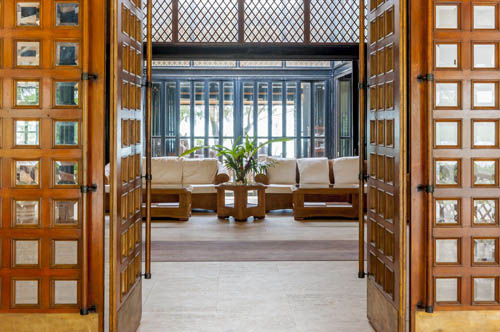
Ouvéa’s breathtakingly beautiful lagoon is a UNESCO World Heritage site and Mouli beach, which stretches alongside the hotel, is famed as one of the world’s loveliest beaches. Inside the hotel, you can purchase woven articles and traditional sculptures made by Ouvéa artisans.
Ouvéa, Loyalty Islands Province
 45.54.00
45.54.00- This email address is being protected from spambots. You need JavaScript enabled to view it.


Work and designs by ARDICI artisans featured at this venue :
HELEWANA
TRIBAL CUT
Markets
Wé Market
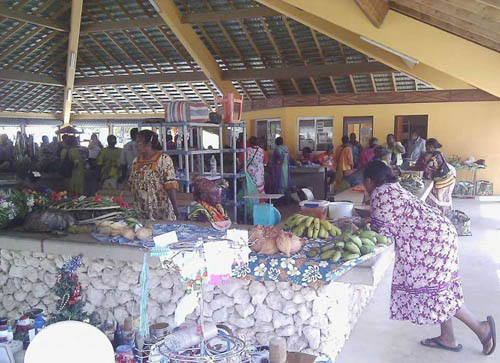
Relaxed, friendly market held in the big market hall in central Wé, with a host of stalls selling local produce and handicrafts. The market is a favourite meeting-place for the Lifou islanders and a key opportunity to promote local skills and show off island produce and crafts to visitors.
Wé, Lifou, Loyalty Islands Province
Every Wednesday and Friday from 6 to 11 a.m.
Work and designs by ARDICI artisans featured at this venue :
BOUG’ILES
CORINNE HNEPUHNYA

